Review on the Tensile Properties and Strengthening Mechanisms of Additive Manufactured CoCrFeNi-Based High-Entropy Alloys
Abstract
:1. Introduction
2. Additive Manufacturing of CoCrFeNi-Based Alloys
2.1. Powder Bed Fusion
2.1.1. Laser Powder Bed Fusion
2.1.2. Electron Beam Melting
2.2. Directed Energy Deposition
3. The Design and Strengthening of CoCrFeNi-Based HEAs
3.1. Addition of Element(s)
3.2. Additive of Micro/Nanoparticles
4. Post-Treatment Strategies for AMed HEAs
5. Summary and Perspective
Author Contributions
Funding
Data Availability Statement
Conflicts of Interest
References
- Yeh, J.-W.; Chen, S.-K.; Lin, S.-J.; Gan, J.-Y.; Chin, T.-S.; Shun, T.-T.; Tsau, C.-H.; Chang, S.-Y. Nanostructured high-entropy alloys with multiple principal elements: Novel alloy design concepts and outcomes. Adv. Eng. Mater. 2004, 6, 299–303. [Google Scholar] [CrossRef]
- Cantor, B.; Chang, I.T.H.; Knight, P.; Vincent, A.J.B. Microstructural development in equiatomic multicomponent alloys. Mater. Sci. Eng. A 2004, 375, 213–218. [Google Scholar] [CrossRef]
- Zou, Y.; Okle, P.; Yu, H.; Sumigawa, T.; Kitamura, T.; Maiti, S.; Steurer, W.; Spolenak, R. Fracture properties of a refractory high-entropy alloy: In situ micro-cantilever and atom probe tomography studies. Scr. Mater. 2017, 128, 95–99. [Google Scholar] [CrossRef]
- Roy, U.; Roy, H.; Daoud, H.; Glatzel, U.; Ray, K. Fracture toughness and fracture micromechanism in a cast AlCoCrCuFeNi high entropy alloy system. Mater. Lett. 2014, 132, 186–189. [Google Scholar] [CrossRef]
- Chen, C.; Pang, S.J.; Cheng, Y.Y.; Zhang, T. Microstructure and mechanical properties of Al20−xCr20+0.5xFe20Co20Ni20+0.5x high entropy alloys. J. Alloys Compd. 2016, 659, 279–287. [Google Scholar] [CrossRef]
- He, J.Y.; Liu, W.H.; Wang, H.; Wu, Y.; Liu, X.J.; Nieh, T.G.; Lu, Z.P. Effects of Al addition on structural evolution and tensile properties of the FeCoNiCrMn high-entropy alloy system. Acta Mater. 2014, 62, 105–113. [Google Scholar] [CrossRef]
- Hong, S.I.; Moon, J.; Hong, S.K.; Kim, H.S. Thermally activated deformation and the rate controlling mechanism in CoCrFeMnNi high entropy alloy. Mater. Sci. Eng. A 2017, 682, 569–576. [Google Scholar] [CrossRef]
- Wang, C.; Li, T.H.; Liao, Y.C.; Li, C.L.; Jang, J.S.C.; Hsueh, C.H. Hardness and strength enhancements of CoCrFeMnNi high-entropy alloy with Nd doping. Mater. Sci. Eng. A 2019, 764, 138192. [Google Scholar] [CrossRef]
- Kumar, N.; Li, C.; Leonard, K.J.; Bei, H.; Zinkle, S.J. Microstructural stability and mechanical behavior of FeNiMnCr high entropy alloy under ion irradiation. Acta Mater. 2016, 113, 230–244. [Google Scholar] [CrossRef]
- Yang, T.F.; Xia, S.Q.; Guo, W.; Hu, R.; Poplawsky, J.D.; Sha, G.; Fang, Y.; Yan, Z.F.; Wang, C.X.; Li, C.Y.; et al. Effects of temperature on the irradiation responses of Al0.1CoCrFeNi high entropy alloy. Scr. Mater. 2018, 144, 31–35. [Google Scholar] [CrossRef]
- Gu, L.; Liang, N.N.; Liu, Y.; Chen, Y.Y.; Liu, J.H.; Sun, Y.X.; Zhao, Y.H. Novel as-cast NiAlCoFeNb dual-phase high-entropy alloys with high hardness. Mater. Lett. 2022, 324, 132676. [Google Scholar] [CrossRef]
- Schuh, B.; Mendez-Martin, F.; Völker, B.; George, E.P.; Clemens, H.; Pippan, R.; Hohenwarter, A. Mechanical properties, microstructure and thermal stability of a nanocrystalline CoCrFeMnNi high-entropy alloy after severe plastic deformation. Acta Mater. 2015, 96, 258–268. [Google Scholar] [CrossRef]
- Xie, J.; Dong, H.; Hao, Y.; Fan, Z.; Wang, C.A. Exploring the Formation Mechanism of Deformation Twins in CrMnFeCoNi High Entropy Alloy. Acta Metall. Sin. (Engl. Lett.) 2022, 35, 1275–1280. [Google Scholar] [CrossRef]
- Feng, S.; Guan, S.; Story, W.A.; Ren, J.; Zhang, S.; Te, A.; Gleason, M.A.; Heelan, J.; Walde, C.; Birt, A.; et al. Cold Spray Additive Manufacturing of CoCrFeNiMn High-Entropy Alloy: Process Development, Microstructure, and Mechanical Properties. J. Therm. Spray Technol. 2022, 42, 720–734. [Google Scholar] [CrossRef]
- Zhang, J.; Yan, Y.; Li, B. Selective Laser Melting (SLM) Additively Manufactured CoCrFeNiMn High-Entropy Alloy: Process Optimization, Microscale Mechanical Mechanism, and High-Cycle Fatigue Behavior. Materials 2022, 15, 8560. [Google Scholar] [CrossRef] [PubMed]
- Zou, Y.; Li, S.; Li, Y. Revealing the deformation mechanisms of the heterogeneous structured CrMnFeCoNi high entropy alloy with ameliorated mechanical and corrosion resistance properties. Surf. Coat. Technol. 2022, 441, 128558. [Google Scholar] [CrossRef]
- Qiao, Y.; Chen, Y.; Cao, F.H.; Wang, H.Y.; Dai, L.H. Dynamic behavior of CrMnFeCoNi high-entropy alloy in impact tension. Int. J. Impact Eng. 2021, 158, 104008. [Google Scholar] [CrossRef]
- Wagner, C.; Laplanche, G. Effect of grain size on critical twinning stress and work hardening behavior in the equiatomic CrMnFeCoNi high-entropy alloy. Int. J. Plast. 2023, 166, 103651. [Google Scholar] [CrossRef]
- Zhang, X.; Liu, L.; Yao, K.; Duan, K.; Wu, F.; Zhao, R.; Zhang, Y.; Shang, J.; Chen, M. The phase composition characteristics of AlCoCrFeNi high entropy alloy heat-treated by simple normalizing treatment and its effects on mechanical properties. J. Alloys Compd. 2022, 926, 166896. [Google Scholar] [CrossRef]
- Castañeda, J.A.; Zambrano, O.A.; Alcázar, G.A.; Rodríguez, S.A.; Coronado, J.J. Stacking Fault Energy Determination in Fe-Mn-Al-C Austenitic Steels by X-ray Diffraction. Metals 2021, 11, 1701. [Google Scholar] [CrossRef]
- Liu, S.F.; Wu, Y.; Wang, H.T.; Lin, W.T.; Shang, Y.Y.; Liu, J.B.; An, K.; Liu, X.J.; Wang, H.; Lu, Z.P. Transformation-reinforced high-entropy alloys with superior mechanical properties via tailoring stacking fault energy. J. Alloys Compd. 2019, 792, 444–455. [Google Scholar] [CrossRef]
- Zhang, Y.H.; Zhuang, Y.; Hu, A.; Kai, J.J.; Liu, C.T. The origin of negative stacking fault energies and nano-twin formation in face-centered cubic high entropy alloys. Scr. Mater. 2017, 130, 96–99. [Google Scholar] [CrossRef]
- Zheng, T.; Lv, J.; Wu, Y.; Wu, H.-H.; Liu, S.; Tang, J.; Zhou, M.; Wang, H.; Liu, X.; Jiang, S.; et al. Effects of stacking fault energy on the deformation behavior of CoNiCrFeMn high-entropy alloys: A molecular dynamics study. Appl. Phys. Lett. 2021, 119, 201907. [Google Scholar] [CrossRef]
- Zhang, X.; Dong, R.; Guo, Q.; Hou, H.; Zhao, Y. Predicting the stacking fault energy in FCC high-entropy alloys based on data-driven machine learning. J. Mater. Res. Technol. 2023, 26, 4813–4824. [Google Scholar] [CrossRef]
- Xiao, J.; Wu, N.; Ojo, O.; Deng, C. Stacking fault and transformation-induced plasticity in nanocrystalline high-entropy alloys. J. Mater. Res. 2021, 36, 2705–2714. [Google Scholar] [CrossRef]
- Ai, C.; He, F.; Guo, M.; Zhou, J.; Wang, Z.J.; Yuan, Z.W.; Guo, Y.J.; Liu, Y.L.; Liu, L. Alloy design, micromechanical and macromechanical properties of CoCrFeNiTax eutectic high entropy alloys. J. Alloys Compd. 2018, 735, 2653–2662. [Google Scholar] [CrossRef]
- Niu, Z.Z.; Xu, J.; Wang, T.; Wang, N.R.; Han, Z.H.; Wang, Y. Microstructure, mechanical properties and corrosion resistance of CoCrFeNiWx (x = 0, 0.2, 0.5) high entropy alloys. Intermetallics 2019, 112, 106550. [Google Scholar] [CrossRef]
- Jiang, H.; Jiang, L.; Qiao, D.X.; Lu, Y.P.; Wang, T.M.; Cao, Z.Q.; Li, T.J. Effect of Niobium on Microstructure and Properties of the CoCrFeNbxNi High Entropy Alloys. J. Mater. Sci. Technol. 2017, 33, 712–717. [Google Scholar] [CrossRef]
- Niu, Z.Z.; Wang, Y.Z.; Geng, C.; Xu, J.; Wang, Y. Microstructural evolution, mechanical and corrosion behaviors of as-annealed CoCrFeNiMox (x = 0, 0.2, 0.5, 0.8, 1) high entropy alloys. J. Alloys Compd. 2020, 820, 153273. [Google Scholar] [CrossRef]
- Xu, Z.J.; Li, Z.T.; Tong, Y.; Zhang, W.D.; Wu, Z.G. Microstructural and mechanical behavior of a CoCrFeNiCu4 non-equiatomic high entropy alloy. J. Mater. Sci. Technol. 2021, 60, 35–43. [Google Scholar] [CrossRef]
- Lv, Y.K.; Hu, R.Y.; Yao, Z.H.; Chen, J.; Xu, D.P.; Liu, Y.; Fan, X.H. Cooling rate effect on microstructure and mechanical properties of AlxCoCrFeNi high entropy alloys. Mater. Des. 2017, 132, 392–399. [Google Scholar] [CrossRef]
- Bandyopadhyay, A.; Traxel, K.D.; Lang, M.; Juhasz, M.; Eliaz, N.; Bose, S. Alloy design via additive manufacturing: Advantages, challenges, applications and perspectives. Mater. Today 2022, 52, 207–224. [Google Scholar] [CrossRef]
- Frazier, W.E. Metal additive manufacturing: A review. J. Mater. Eng. Perform. 2014, 23, 1917–1928. [Google Scholar] [CrossRef]
- Bandyopadhyay, A.; Zhang, Y.; Bose, S. Recent developments in metal additive manufacturing. Curr. Opin. Chem. Eng. 2020, 28, 96–104. [Google Scholar] [CrossRef] [PubMed]
- George, E.P.; Raabe, D.; Ritchie, R.O. High- entropy alloys. Nat. Rev. Mater. 2019, 4, 515–534. [Google Scholar] [CrossRef]
- Han, C.; Fang, Q.; Shi, Y.; Tor, S.B.; Chua, C.K.; Zhou, K. Recent Advances on High-Entropy Alloys for 3D Printing. Adv. Mater. 2020, 32, 1903855. [Google Scholar] [CrossRef] [PubMed]
- Li, W.; Xie, D.; Li, D.; Zhang, Y.; Gao, Y.; Liaw, P.K. Mechanical behavior of high-entropy alloys. Prog. Mater. Sci. 2021, 118, 100777. [Google Scholar] [CrossRef]
- Chen, P.; Li, S.; Zhou, Y.H.; Yan, M.; Attallah, M.M. Fabricating CoCrFeMnNi high entropy alloy via selective laser melting in-situ alloying. J. Mater. Sci. Technol. 2020, 43, 40–43. [Google Scholar] [CrossRef]
- Niu, P.D.; Li, R.D.; Yuan, T.C.; Zhu, S.Y.; Chen, C.; Wang, M.B.; Huang, L. Microstructures and properties of an equimolar AlCoCrFeNi high entropy alloy printed by selective laser melting. Intermetallics 2019, 104, 24–32. [Google Scholar] [CrossRef]
- Ren, J.; Zhang, Y.; Zhao, D.X.; Chen, Y.; Guan, S.; Liu, Y.F.; Liu, L.; Peng, S.Y.; Kong, F.Y.; Poplawsky, J.D.; et al. Strong yet ductile nanolamellar high-entropy alloys by additive. Nature 2022, 608, 62–68. [Google Scholar] [CrossRef]
- Wu, W.Q.; Zhou, R.; Wei, B.Q.; Ni, S.; Liu, Y.; Song, M. Nanosized precipitates and dislocation networks reinforced C-containing CoCrFeNi high-entropy alloy fabricated by selective laser melting. Mater. Charact. 2018, 144, 605–610. [Google Scholar] [CrossRef]
- Zhou, R.; Liu, Y.; Zhou, C.S.; Li, S.Q.; Wu, W.Q.; Song, M.; Liu, B.; Liang, X.P.; Liaw, P.K. Microstructures and mechanical properties of C-containing FeCoCrNi high entropy alloy fabricated by selective laser melting. Intermetallics 2018, 94, 165–171. [Google Scholar] [CrossRef]
- Guo, J.; Goh, M.; Zhu, Z.G.; Lee, X.; Nai, M.L.S.; Wei, J. On the machining of selective laser melting CoCrFeMnNi high-entropy alloy. Mater. Des. 2018, 153, 211–220. [Google Scholar] [CrossRef]
- Zhu, Z.G.; Nguyen, Q.B.; Ng, F.L.; An, X.H.; Liao, X.Z.; Liaw, P.K.; Nai, S.M.L.; Wei, J. Hierarchical microstructure and strengthening mechanisms of a CoCrFeNiMn high entropy alloy additively manufactured by selective laser melting. Scr. Mater. 2018, 154, 20–24. [Google Scholar] [CrossRef]
- Zhang, C.; Chen, G.J.; Dai, P.Q. Evolution of the microstructure and properties of laser-clad FeCrNiCoBx high-entropy alloy coatings. Mater. Sci. Technol. 2016, 32, 1666–1672. [Google Scholar] [CrossRef]
- Ocelík, V.; Janssen, N.; Smith, S.N.; De Hosson, J.T.M. Additive Manufacturing of High-Entropy Alloys by Laser Processing. Jom 2016, 68, 1810–1818. [Google Scholar] [CrossRef]
- Cai, Z.B.; Jin, G.; Cui, X.F.; Liu, Z.; Zheng, W.; Li, Y.; Wang, L.Q. Synthesis and microstructure characterization of Ni-Cr-Co-Ti-V-Al high entropy alloy coating on Ti-6Al-4V substrate by laser surface alloying. Mater. Charact. 2016, 120, 229–233. [Google Scholar] [CrossRef]
- Sing, S.L.; Yeong, W.Y. Laser powder bed fusion for metal additive manufacturing: Perspectives on recent developments. Virtual Phys. Prototyp. 2020, 15, 359–370. [Google Scholar] [CrossRef]
- Oliveira, J.P.; LaLonde, A.D.; Ma, J. Processing parameters in laser powder bed fusion metal additive manufacturing. Mater. Des. 2020, 193, 108762. [Google Scholar] [CrossRef]
- Kumar, P.; Farah, J.; Akram, J.; Teng, C.; Ginn, J.; Misra, M. Influence of laser processing parameters on porosity in Inconel 718 during additive manufacturing. Int. J. Adv. Manuf. Technol. 2019, 103, 1497–1507. [Google Scholar] [CrossRef]
- Chattopadhyay, C.; Prasad, A.; Murty, B.S. Phase prediction in high entropy alloys—A kinetic approach. Acta Mater. 2018, 153, 214–225. [Google Scholar] [CrossRef]
- Lee, K.S.; Bae, B.; Kang, J.H.; Lim, K.R.; Na, Y.S. Multi-phase refining of an AlCoCrFeNi high entropy alloy by hot compression. Mater. Lett. 2017, 198, 81–84. [Google Scholar] [CrossRef]
- Sun, Z.J.; Tan, X.P.; Wang, C.C.; Descoins, M.; Mangelinck, D.; Tor, S.B.; Jägle, E.A.; Zaefferer, S.; Raabe, D. Reducing hot tearing by grain boundary segregation engineering in additive manufacturing: Example of an AlxCoCrFeNi high-entropy alloy. Acta Mater. 2021, 204, 116505. [Google Scholar] [CrossRef]
- Peyrouzet, F.; Hachet, D.; Soulas, R.; Navone, C.; Godet, S.; Gorsse, S. Selective Laser Melting of Al0.3CoCrFeNi High-Entropy Alloy: Printability, Microstructure, and Mechanical Properties. JOM 2019, 71, 3443–3451. [Google Scholar] [CrossRef]
- Sun, K.; Peng, W.X.; Yang, L.L.; Fang, L. Effect of SLM Processing Parameters on Microstructures and Mechanical Properties of Al0.5CoCrFeNi High Entropy Alloys. Metals 2020, 10, 292. [Google Scholar] [CrossRef]
- Karlsson, D.; Marshal, A.; Johansson, F.; Schuisky, M.; Sahlberg, M.; Schneider, J.M.; Jansson, U. Elemental segregation in an AlCoCrFeNi high-entropy alloy—A comparison between selective laser melting and induction melting. J. Alloys Compd. 2019, 784, 195–203. [Google Scholar] [CrossRef]
- Chen, X.S.; Kong, J.; Li, J.L.; Feng, S.; Li, H.; Wang, Q.P.; Liang, Y.Z.; Dong, K.W.; Yang, Y. High-strength AlCoCrFeNi2.1 eutectic high entropy alloy with ultrafine lamella structure via additive manufacturing. Mater. Sci. Eng. A 2022, 854, 143816. [Google Scholar] [CrossRef]
- Zhou, P.F.; Xiao, D.H.; Wu, Z.; Ou, X.Q. Al0.5FeCoCrNi high entropy alloy prepared by selective laser melting with gas-atomized pre-alloy powders. Mater. Sci. Eng. A 2019, 73, 86–89. [Google Scholar] [CrossRef]
- Chen, P.; Yao, X.Y.; Attallah, M.M.; Yan, M. In-situ alloyed CoCrFeMnNi high entropy alloy: Microstructural development in laser powder bed fusion. J. Mater. Sci. Technol. 2022, 123, 123–135. [Google Scholar] [CrossRef]
- Li, R.D.; Niu, P.D.; Yuan, T.C.; Cao, P.; Chen, C.; Zhou, K.C. Selective laser melting of an equiatomic CoCrFeMnNi high-entropy alloy: Processability, non-equilibrium microstructure and mechanical property. J. Alloys Compd. 2018, 746, 125–134. [Google Scholar] [CrossRef]
- Lu, T.W.; Yao, N.; Chen, H.Y.; Sun, B.H.; Chen, X.Y.; Scudino, S.; Kosiba, K.; Zhang, X.C. Exceptional strength-ductility combination of additively manufactured high-entropy alloy matrix composites reinforced with TiC nanoparticles at room and cryogenic temperatures. Addit. Manuf. 2022, 56, 102918. [Google Scholar] [CrossRef]
- Fujieda, T.; Chen, M.C.; Shiratori, H.; Kuwabara, K.; Yamanaka, K.; Koizumi, Y.; Chiba, A.; Watanabe, S. Mechanical and corrosion properties of CoCrFeNiTi-based high-entropy alloy additive manufactured using selective laser melting. Addit. Manuf. 2019, 25, 412–420. [Google Scholar] [CrossRef]
- Li, N.; Wu, S.X.; Ouyang, D.; Zhang, J.J.; Liu, L. Fe-based metallic glass reinforced FeCoCrNiMn high entropy alloy through selective laser melting. J. Alloys Compd. 2020, 822, 153695. [Google Scholar] [CrossRef]
- Song, M.; Zhou, R.; Gu, J.; Wang, Z.W.; Ni, S.; Liu, Y. Nitrogen induced heterogeneous structures overcome strength-ductility trade-off in an additively manufactured high-entropy alloy. Appl. Mater. Today 2020, 18, 100498. [Google Scholar] [CrossRef]
- Kim, J.G.; Park, J.M.; Seol, J.B.; Choe, J.; Yu, J.H.; Yang, S.; Kim, H.S. Nano-scale solute heterogeneities in the ultrastrong selectively laser melted carbon-doped CoCrFeMnNi alloy. Mater. Sci. Eng. A 2020, 773, 138726. [Google Scholar] [CrossRef]
- Chen, H.Y.; Lu, T.W.; Wang, Y.G.; Liu, Y.; Shi, T.Y.; Prashanth, K.G.; Kosiba, K. Laser additive manufacturing of nano-TiC particles reinforced CoCrFeMnNi high-entropy alloy matrix composites with high strength and ductility. Mater. Sci. Eng. A 2022, 833, 142512. [Google Scholar] [CrossRef]
- Li, B.; Zhang, L.; Xu, Y.; Liu, Z.Y.; Qian, B.; Xuan, F.Z. Selective laser melting of CoCrFeNiMn high entropy alloy powder modified with nano-TiN particles for additive manufacturing and strength enhancement: Process, particle behavior and effects. Powder Technol. 2020, 360, 509–521. [Google Scholar] [CrossRef]
- Li, B.; Qian, B.; Xu, Y.; Liu, Z.Y.; Xuan, F.Z. Fine-structured CoCrFeNiMn high-entropy alloy matrix composite with 12 wt% TiN particle reinforcements via selective laser melting assisted additive manufacturing. Mater. Lett. 2019, 252, 88–91. [Google Scholar] [CrossRef]
- Ikeda, T.; Yonehara, M.; Ikeshoji, T.T.; Nobuki, T.; Hatate, M.; Kuwabara, K.; Otsubo, Y.; Kyogoku, H. Influences of Process Parameters on the Microstructure and Mechanical Properties of CoCrFeNiTi Based High-Entropy Alloy in a Laser Powder Bed Fusion Process. Crystals 2021, 11, 549. [Google Scholar] [CrossRef]
- Zhou, R.; Liu, Y.; Liu, B.; Li, J.; Fang, Q.H. Precipitation behavior of selective laser melted FeCoCrNiC0.05 high entropy alloy. Intermetallics 2019, 106, 20–25. [Google Scholar] [CrossRef]
- Biamino, S.; Penna, A.; Ackelid, U.; Sabbadini, S.; Tassa, O.; Fino, P.; Pavese, M.; Gennaro, P.; Badini, C. Electron beam melting of Ti-48Al-2Cr-2Nb alloy: Microstructure and mechanical properties investigation. Intermetallics 2011, 19, 776–781. [Google Scholar] [CrossRef]
- Zhao, X.L.; Li, S.J.; Zhang, M.; Liu, Y.D.; Sercombe, T.B.; Wang, S.G.; Hao, Y.L.; Yang, R.; Murr, L.E. Comparison of the microstructures and mechanical properties of Ti–6Al–4V fabricated by selective laser melting and electron beam melting. Mater. Des. 2016, 95, 21–31. [Google Scholar] [CrossRef]
- Murr, L.E.; Quinones, S.A.; Gaytan, S.M.; Lopez, M.L.; Rodela, A.; Martinez, E.Y.; Hernandez, D.H.; Martinez, E.; Medina, F.; Wicker, R.B. Microstructure and mechanical behavior of Ti–6Al–4V produced by rapid-layer manufacturing, for biomedical applications. J. Mech. Behav. Biomed. Mater. 2009, 2, 20–32. [Google Scholar] [CrossRef] [PubMed]
- Rafi, H.K.; Karthik, N.V.; Gong, H.J.; Starr, T.L.; Stucker, B.E. Microstructures and mechanical properties of Ti6Al4V parts fabricated by selective laser melting and electron beam melting. J. Mater. Eng. Perform. 2013, 22, 3872–3883. [Google Scholar] [CrossRef]
- Fujieda, T.; Shiratori, H.; Kuwabara, K.; Kato, T.; Yamanaka, K.; Koizumi, Y.; Chiba, A. First demonstration of promising selective electron beam melting method for utilizing high-entropy alloys as engineering materials. Mater. Lett. 2015, 159, 12–15. [Google Scholar] [CrossRef]
- Shiratori, H.; Fujieda, T.; Yamanaka, K.; Koizumi, Y.; Kuwabara, K.; Kato, T.; Chiba, A. Relationship between the microstructure and mechanical properties of an equiatomic AlCoCrFeNi high-entropy alloy fabricated by selective electron beam melting Mater. Sci. Eng. A 2016, 656, 39–46. [Google Scholar] [CrossRef]
- Fujieda, T.; Shiratori, H.; Kuwabara, K.; Hirota, M.; Kato, T.; Yamanaka, K.; Koizumi, Y.; Chiba, A.; Watanabe, S. CoCrFeNiTi-based high-entropy alloy with superior tensile strength and corrosion resistance achieved by a combination of additive manufacturing using selective electron beam melting and solution treatment. Mater. Lett. 2017, 189, 148–151. [Google Scholar] [CrossRef]
- Kuwabara, K.; Shiratori, H.; Fujieda, T.; Yamanaka, K.; Koizumi, Y.; Chiba, A. Mechanical and corrosion properties of AlCoCrFeNi high-entropy alloy fabricated with selective electron beam melting. Addit. Manuf. 2018, 23, 264–271. [Google Scholar] [CrossRef]
- Sui, Q.X.; Wang, Z.; Wang, J.; Xu, S.R.; Liu, B.; Yuan, Q.; Zhao, F.J.; Gong, L.; Liu, J. Additive manufacturing of CoCrFeNiMo eutectic high entropy alloy: Microstructure and mechanical properties. J. Alloys Compd. 2022, 913, 165239. [Google Scholar] [CrossRef]
- Wang, P.; Huang, P.; Ng, F.L.; Sin, W.J.; Lu, S.; Nai ML, S.; Dong, Z.; Wei, J. Additively manufactured CoCrFeNiMn high-entropy alloy via pre-alloyed powder. Mater. Des. 2019, 168, 107576. [Google Scholar] [CrossRef]
- Yamanaka, K.; Shiratori, H.; Mori, M.; Omura, K.; Fujieda, T.; Kuwabara, K.; Chiba, A. Corrosion mechanism of an equimolar AlCoCrFeNi high-entropy alloy additively manufactured by electron beam melting. NPJ Mater. Degrad. 2020, 4, 12. [Google Scholar] [CrossRef]
- Herzog, D.; Seyda, V.; Wycisk, E.; Emmelmann, C. Additive manufacturing of metals. Acta Mater. 2016, 117, 371–392. [Google Scholar] [CrossRef]
- Melia, M.A.; Carroll, J.D.; Whetten, S.R.; Esmaeely, S.N.; Locke, J.; White, E.; Anderson, I.; Chandross, M.; Michael, J.R.; Argibay, N.; et al. Mechanical and Corrosion Properties of Additively Manufactured CoCrFeMnNi High Entropy Alloy. Addit. Manuf. 2019, 29, 100833. [Google Scholar] [CrossRef]
- Haase, C.; Tang, F.; Wilms, M.B.; Weisheit, A.; Hallstedt, B. Combining thermodynamic modeling and 3D printing of elemental powder blends for high-throughput investigation of high-entropy alloys—Towards rapid alloy screening and design. Mater. Sci. Eng. A 2017, 688, 180–189. [Google Scholar] [CrossRef]
- Xiang, S.; Luan, H.W.; Wu, J.; Yao, K.F.; Li, J.F.; Liu, X.; Tian, Y.Z.; Mao, W.L.; Bai, H.; Le, G.M.; et al. Microstructures and mechanical properties of CrMnFeCoNi high entropy alloys fabricated using laser metal deposition technique. J. Alloys Compd. 2019, 773, 387–392. [Google Scholar] [CrossRef]
- Qiu, Z.; Yao, C.; Feng, K.; Li, Z.; Chu, P.K. Cryogenic deformation mechanism of CrMnFeCoNi high-entropy alloy fabricated by laser additive manufacturing process. Int. J. Lightweight Mater. Manuf. 2018, 1, 33–39. [Google Scholar] [CrossRef]
- Tong, Z.P.; Liu, H.L.; Jiao, J.F.; Zhou, W.F.; Yang, Y.; Ren, X.D. Improving the strength and ductility of laser directed energy deposited CrMnFeCoNi high-entropy alloy by laser shock peening. Addit. Manuf. 2020, 35, 101417. [Google Scholar] [CrossRef]
- Gao, X.Y.; Lu, Y.Z. Laser 3D printing of CoCrFeMnNi high-entropy alloy. Mater. Lett. 2019, 236, 77–80. [Google Scholar] [CrossRef]
- Wang, R.; Zhang, K.; Davies, C.; Wu, X.H. Evolution of microstructure, mechanical and corrosion properties of AlCoCrFeNi high-entropy alloy prepared by direct laser fabrication. J. Alloys Compd. 2017, 694, 971–981. [Google Scholar] [CrossRef]
- Kunce, I.; Polanski, M.; Karczewski, K.; Plocinski, T.; Kurzydlowski, K.J. Microstructural characterisation of high-entropy alloy AlCoCrFeNi fabricated by laser engineered net shaping. J. Alloys Compd. 2015, 648, 751–758. [Google Scholar] [CrossRef]
- Vikram, R.J.; Murty, B.S.; Fabijanic, D.; Suwas, S. Insights into micro-mechanical response and texture of the additively manufactured eutectic high entropy alloy AlCoCrFeNi2.1. J. Alloys Compd. 2020, 827, 154034. [Google Scholar] [CrossRef]
- Shen, Q.K.; Xue, J.X.; Zheng, Z.H.; Yu, X.Y.; Ou, N. Effect of thermal cycling on the microstructure and mechanical properties of AlCoCrFeNi2.1 high-entropy alloy fabricated using powder plasma arc additive manufacturing. Mater. Lett. 2022, 325, 132902. [Google Scholar] [CrossRef]
- Nartu, M.; Alamd, T.; Dasari, S.; Mantri, S.A.; Gorsse, S.; Siller, H.; Dahotre, N.; Banerjee, R. Enhanced tensile yield strength in laser additively manufactured Al0.3CoCrFeNi high entropy alloy. Materialia 2020, 9, 100522. [Google Scholar] [CrossRef]
- Nartu, M.; Chesetti, A.; Sharma, A.; Mantri, S.A.; Dahotre, N.B.; Banerjee, R. Engineering heterogeneous microstructures in additively manufactured high entropy alloys for high strength and strain hardenability. Mater. Sci. Eng. A. 2022, 849, 143505. [Google Scholar] [CrossRef]
- Joseph, J.; Jarvis, T.; Wu, X.H.; Stanford, N.; Hodgson, P.; Fabijanic, D.M. Comparative study of the microstructures and mechanical properties of direct laser fabricated and arc-melted AlxCoCrFeNi high entropy alloys. Mater. Sci. Eng. A 2015, 633, 184–193. [Google Scholar] [CrossRef]
- Cai, Z.B.; Wang, Y.D.; Cui, X.F.; Jin, G.; Li, Y.; Liu, Z.; Dong, M.L. Design and microstructure characterization of FeCoNiAlCu high-entropy alloy coating by plasma cladding: In comparison with thermodynamic calculation. Surf. Coat. Technol. 2017, 330, 163–169. [Google Scholar] [CrossRef]
- Chew, Y.; Bi, G.J.; Zhu, Z.G.; Ng, F.L.; Weng, F.; Liu, S.B.; Nai SM, L.; Lee, B.Y. Microstructure and enhanced strength of laser aided additive manufactured CoCrFeNiMn high entropy alloy. Mater. Sci. Eng. A 2019, 744, 137–144. [Google Scholar] [CrossRef]
- Wang, Q.; Amar, A.; Jiang, C.L.; Luan, H.W.; Zhao, S.F.; Zhang, H.; Le, G.M.; Liu, X.; Wang, X.Y.; Yang, X.S.; et al. CoCrFeNiMo0.2 high entropy alloy by laser melting deposition: Prospective material for low temperature and corrosion resistant applications. Intermetallics 2020, 119, 1106727. [Google Scholar] [CrossRef]
- Zhou, K.X.; Li, J.J.; Wang, L.L.; Yang, H.O.; Wang, Z.J.; Wang, J.C. Direct laser deposited bulk CoCrFeNiNbx high entropy alloys. Intermetallics 2019, 114, 106592. [Google Scholar] [CrossRef]
- Shen, Q.K.; Xue, J.X.; Yu, X.Y.; Zheng, Z.H.; Ou, N. Powder plasma arc additive manufacturing of CoCrFeNiWx high-entropy alloys: Microstructure evolution and mechanical properties. J. Alloys Compd. 2022, 922, 166245. [Google Scholar] [CrossRef]
- Xiang, S.; Li, J.F.; Luan, H.W.; Amar, A.; Lu, S.Y.; Li, K.; Zhang, L.; Liu, X.; Le, G.M.; Wang, X.Y.; et al. Effects of process parameters on microstructures and tensile properties of laser melting deposited CrMnFeCoNi high entropy alloys. Mater. Sci. Eng. A 2019, 743, 412–417. [Google Scholar] [CrossRef]
- Amar, A.; Li, J.F.; Xiang, S.; Liu, X.; Zhou, Y.Z.; Le, G.M.; Wang, X.Y.; Qu, F.S.; Ma, S.Y.; Dong, W.M.; et al. Additive manufacturing of high-strength CrMnFeCoNi-based High Entropy Alloys with TiC addition. Intermetallics 2019, 109, 162–166. [Google Scholar] [CrossRef]
- Li, J.F.; Xiang, S.; Luan, H.W.; Amar, A.; Liu, X.; Lu, S.Y.; Zeng, Y.Y.; Le, G.M.; Wang, X.Y.; Qu, F.S.; et al. Additive manufacturing of high-strength CrMnFeCoNi high-entropy alloys-based composites with WC addition. J. Mater. Sci. Technol. 2019, 35, 2430–2434. [Google Scholar] [CrossRef]
- Tong, Z.P.; Ren, X.D.; Jiao, J.F.; Zhou, W.F.; Ren, Y.P.; Ye, Y.X.; Larson, E.A.; Gu, J.Y. Laser additive manufacturing of FeCrCoMnNi high-entropy alloy: Effect of heat treatment on microstructure, residual stress and mechanical property. J. Alloys Compd. 2019, 78, 1144–1159. [Google Scholar] [CrossRef]
- Lin, Y.C.; Cho, Y.H. Elucidating the microstructure and wear behavior for multicomponent alloy clad layers by in situ synthesis. Surf. Coat. Technol. 2008, 202, 4666–4672. [Google Scholar] [CrossRef]
- Lin, Y.C.; Cho, Y.H. Elucidating the microstructural and tribological characteristics of NiCrAlCoCu and NiCrAlCoMo multicomponent alloy clad layers synthesized in situ. Surf. Coat. Technol. 2009, 203, 1694–1701. [Google Scholar] [CrossRef]
- Ye, F.X.; Yang, Y.; Lou, Z.; Feng, L.Z.; Guo, L.; Yu, J.X. Microstructure and wear resistance of TiC reinforced AlCoCrFeNi2.1 eutectic high entropy alloy layer fabricated by micro-plasma cladding. Mater. Lett. 2021, 284, 128859. [Google Scholar] [CrossRef]
- Chao, Q.; Guo, T.T.; Jarvis, T.; Wu, X.H.; Hodgson, P.; Fabijanic, D. Direct laser deposition cladding of AlxCoCrFeNi high entropy alloys on a high-temperature stainless steel. Surf. Coat. Technol. 2017, 332, 440–451. [Google Scholar] [CrossRef]
- Dobbelstein, H.; Gurevich, E.L.; George, E.P.; Ostendorf, A.; Laplanche, G. Laser metal deposition of compositionally graded TiZrNbTa refractory high-entropy alloys using elemental powder blends. Addit. Manuf. 2019, 25, 252–262. [Google Scholar] [CrossRef]
- Gwalani, B.; Gangireddy, S.; Shukla, S.; Yannetta, C.J.; Valentin, S.G.; Mishra, R.S.; Banerjee, R. Compositionally graded high entropy alloy with a strong front and ductile back. Mater. Today Commun. 2019, 20, 100602. [Google Scholar] [CrossRef]
- Welk, B.A.; Williams RE, A.; Viswanathan, G.B.; Gibson, M.A.; Liaw, P.K.; Fraser, H.L. Nature of the interfaces between the constituent phases in the high entropy alloy CoCrCuFeNiAl. Ultramicroscopy 2013, 134, 193–199. [Google Scholar] [CrossRef] [PubMed]
- Borkar, T.; Gwalani, B.; Choudhuri, D.; Mikler, C.V.; Yannetta, C.J.; Chen, X.; Ramanujan, R.V.; Styles, M.J.; Gibson, M.A.; Banerjee, R. A combinatorial assessment of AlxCrCuFeNi2 (0 < x < 1.5) complex concentrated alloys: Microstructure, microhardness, and magnetic properties. Acta Mater. 2016, 116, 63–76. [Google Scholar]
- Gwalani, B.; Soni, V.; Waseem, O.A.; Mantri, S.A.; Banerjee, R. Laser additive manufacturing of compositionally graded AlCrFeMoVx (x = 0 to 1) high-entropy alloy system. Opt. Laser Technol. 2019, 113, 330–337. [Google Scholar] [CrossRef]
- Pegues, J.W.; Melia, M.A.; Puckett, R.; Whetten, S.R.; Argibay, N.; Kustas, A.B. Exploring additive manufacturing as a high-throughput screening tool for multiphase high entropy alloys. Addit. Manuf. 2021, 37, 101598. [Google Scholar] [CrossRef]
- Li, Z.M.; Ludwig, A.; Savan, A.; Springer, H.; Raabe, D. Combinatorial metallurgical synthesis and processing of high-entropy alloys. J. Mater. Res. 2018, 33, 3156–3169. [Google Scholar] [CrossRef]
- Guan, S.; Ren, J.; Mooraj, S.; Liu, Y.F.; Feng, S.; Zhang SB, A.; Liu, J.; Fan, X.S.; Liaw, P.K.; Chen, W. Additive Manufacturing of High-Entropy Alloys: Microstructural Metastability and Mechanical Behavior. J. Phase Equilib. Diffus. 2021, 42, 748–771. [Google Scholar] [CrossRef]
- Welk, B.A.; Gibson, M.A.; Fraser, H.L. A Combinatorial Approach to the Investigation of Metal Systems that Form Both Bulk Metallic Glasses and High Entropy Alloys. JOM 2016, 68, 1021–1026. [Google Scholar] [CrossRef]
- Borkar, T.; Chaudhary, V.; Gwalani, B.; Choudhuri, D.; Mikler, C.V.; Soni, V.; Alam, T.; Ramanujan, R.V.; Banerjee, R. A Combinatorial Approach for Assessing the Magnetic Properties of High Entropy Alloys: Role of Cr in AlCoxCr1–xFeNi. Adv. Eng. Mater. 2017, 19, 1700048. [Google Scholar] [CrossRef]
- Vaidya, M.; Guruvidyathri, K.; Murty, B.S. Phase formation and thermal stability of CoCrFeNi and CoCrFeMnNi equiatomic high entropy alloys. J. Alloys Compd. 2019, 774, 856–864. [Google Scholar] [CrossRef]
- Salishchev, G.A.; Tikhonovsky, M.A.; Shaysultanov, D.G.; Stepanov, N.D.; Kuznetsov, A.V.; Kolodiy, I.V.; Tortika, A.S.; Senkov, O.N. Effect of Mn and V on structure and mechanical properties of high-entropy alloys based on CoCrFeNi system. J. Alloys Compd. 2014, 591, 11–21. [Google Scholar] [CrossRef]
- Wang, H.; Zhu, Z.G.; Chen, H.; Wang, A.G.; Liu, J.Q.; Liu, H.W.; Zheng, R.K.; Nai SM, L.; Primig, S.; Babu, S.S.; et al. Effect of cyclic rapid thermal loadings on the microstructural evolution of a CrMnFeCoNi high-entropy alloy manufactured by selective laser melting. Acta Mater. 2020, 196, 609–625. [Google Scholar] [CrossRef]
- Sun, S.J.; Tian, Y.Z.; Lin, H.R.; Yang, H.J.; Dong, X.G.; Wang, Y.H.; Zhang, Z.F. Transition of twinning behavior in CoCrFeMnNi high entropy alloy with grain refinement. Mater. Sci. Eng. A 2018, 712, 603–607. [Google Scholar] [CrossRef]
- Li, Z.M.; Tasan, C.C.; Pradeep, K.G.; Raabe, D. A TRIP-assisted dual-phase high-entropy alloy: Grain size and phase fraction effects on deformation behavior. Acta Mater. 2017, 131, 323–335. [Google Scholar] [CrossRef]
- Nutor, R.K.; Cao, Q.P.; Wei, R.; Su, Q.M.; Du, G.H.; Wang, X.D.; Li, F.S.; Zhang, D.X.; Jiang, J.Z. A dual-phase alloy with ultrahigh strength-ductility synergy over a wide temperature range. Sci. Adv. 2021, 7, 4404. [Google Scholar] [CrossRef] [PubMed]
- Joseph, J.; Stanford, N.; Hodgson, P.; Fabijanic, D.M. Tension/compression asymmetry in additive manufactured face centered cubic high entropy alloy. Scr. Mater. 2017, 129, 30–34. [Google Scholar] [CrossRef]
- Huang, L.F.; Sun, Y.N.; Chen, N.; Luan, H.W.; Le, G.M.; Liu, X.; Ji, Y.Q.; Lu, Y.P.; Liaw, P.K.; Yang, X.S.; et al. Simultaneously enhanced strength-ductility of AlCoCrFeNi2.1 eutectic high-entropy alloy via additive manufacturing. Mater. Sci. Eng. A 2022, 830, 142327. [Google Scholar] [CrossRef]
- Guan, S.; Wan, D.; Solberg, K.; Berto, G.; Welo, T.; Yue, T.M.; Chan, K.C. Additive manufacturing of fine-grained and dislocation-populated CrMnFeCoNi high entropy alloy by laser engineered net shaping. Mater. Sci. Eng. A 2019, 76, 138056. [Google Scholar] [CrossRef]
- Seol, J.B.; Bae, J.W.; Li, Z.M.; Han, J.C.; Kim, J.G.; Raabe, D.; Kim, H.S. Boron doped ultrastrong and ductile high-entropy alloys. Acta Mater. 2018, 151, 366–376. [Google Scholar] [CrossRef]
- Zhang, H.; He, Y.Z.; Pan, Y.; He, Y.S.; Shin, K. Synthesis and characterization of NiCoFeCrAl3 high entropy alloy coating by laser cladding. In Proceedings of the International Conference on Manufacturing Science and Engineering (ICMSE 2009), Zhuhai, China, 26–28 December 2009; Trans Tech Publications Ltd.: Stafa, Switzerland, 2009; pp. 1408–1411. [Google Scholar]
- Chen, W.Y.; Zhou, R.; Li, W.P.; Chen, Y.H.; Chou, T.H.; Wang, X.; Liu, Y.; Zhu, Y.T.; Huang, J. Effect of interstitial carbon and nitrogen on corrosion of FeCoCrNi multi-principal element alloys made by selective laser melting. J. Mater. Sci. Technol. 2023, 148, 52–63. [Google Scholar] [CrossRef]
- Zhou, R.; Chen, W.Y.; Li, W.P.; Chou, T.H.; Chen, Y.H.; Liang, X.P.; Luan, J.H.; Zhu, Y.T.; Huang, J.C.; Liu, Y. 3D printed N-doped CoCrFeNi high entropy alloy with more than doubled corrosion resistance in dilute sulphuric acid. NPJ Mater. Degrad. 2023, 7, 8. [Google Scholar] [CrossRef]
- Zhu, Y.T.; Wu, X.L. Heterostructured materials. Prog. Mater. Sci. 2023, 131, 101019. [Google Scholar] [CrossRef]
- Park, J.M.; Choe, J.; Kim, J.G.; Bae, J.W.; Moon, J.; Yang, S.; Kim, S.K.; Yu, J.H.; Kim, H.S. Superior tensile properties of 1%C-CoCrFeMnNi high-entropy alloy additively manufactured by selective laser melting. Mater. Res. Lett. 2020, 8, 1–7. [Google Scholar] [CrossRef]
- Zhu, Z.G.; An, X.H.; Lu, W.J.; Li, Z.M.; Ng, F.L.; Liao, X.Z.; Ramamurty, U.; Nai, S.M.L.; Wei, J. Selective laser melting enabling the hierarchically heterogeneous microstructure and excellent mechanical properties in an interstitial solute strengthened high entropy alloy. Mater. Res. Lett. 2019, 7, 453–459. [Google Scholar] [CrossRef]
- Agrawal, P.; Thapliyal, S.; Nene, S.S.; Mishra, R.S.; McWilliams, B.A.; Cho, K.C. Excellent strength-ductility synergy in metastable high entropy alloy by laser powder bed additive manufacturing. Addit. Manuf. 2020, 32, 101098. [Google Scholar] [CrossRef]
- Kim, Y.K.; Yu, J.H.; Kim, H.S.; Lee, K.A. In-situ carbide-reinforced CoCrFeMnNi high-entropy alloy matrix nanocomposites manufactured by selective laser melting: Carbon content effects on microstructure, mechanical properties, and deformation mechanism. Compos. Part B Eng. 2021, 210, 108638. [Google Scholar] [CrossRef]
- Gao, X.; Liu, T.; Qin, G.; Ren, H.; Zhou, Q.; Chen, R. Nano-twinning induced high strain hardening behavior in a metastable as-cast Co30Cr30Fe20Ni20 high entropy alloy at room temperature. Mater. Charact. 2022, 194, 112420. [Google Scholar] [CrossRef]
- Huang, G.; Li, B.; Chen, Y.; Xuan, F. Nanotwining induced by tensile fatigue and dynamic impact of laser powder bed fusion additively manufactured CoCrFeNi high-entropy alloy. J. Mater. Sci. Technol. 2024, 183, 241–257. [Google Scholar] [CrossRef]
- Rymer, L.M.; Frint, P.; Lindner, T.; Gebel, G.; Löbel, M.; Lampke, T. Strain-Rate Sensitive Deformation Behavior under Tension and Compression of Al0.3CrFeCoNiMo0.2. Adv. Eng. Mater. 2022, 24, 2100921. [Google Scholar] [CrossRef]
- Li, J.; Yamanaka, K.; Chiba, A. Significant lattice-distortion effect on compressive deformation in Mo-added CoCrFeNi-based high-entropy alloys. Mater. Sci. Eng. A 2022, 830, 142295. [Google Scholar] [CrossRef]
- Zhang, L.J.; Yu, P.F.; Fan, J.T.; Zhang, M.D.; Zhang, C.Z.; Cui, H.Z.; Li, G. Investigating the micro and nanomechanical properties of CoCrFeNi-Cx high-entropy alloys containing eutectic carbides. Mater. Sci. Eng. A 2020, 796, 140065. [Google Scholar] [CrossRef]
- Zhang, M.; Hou, J.; Yang, H.; Tan, Y.; Wang, X.; Shi, X.; Guo, R.; Qiao, J. Tensile strength prediction of dual-phase Al0.6CoCrFeNi high-entropy alloys. Int. J. Min. Met. Mater. 2020, 27, 1341. [Google Scholar] [CrossRef]
- Shen, Q.K.; Kong, X.D.; Chen, X.Z.; Yao, X.K.; Deev, V.B.; Prusov, E.S. Powder plasma arc additive manufactured CoCrFeNi(SiC)x high-entropy alloys: Microstructure and mechanical properties. Mater. Lett. 2021, 282, 128736. [Google Scholar] [CrossRef]
- Wu, Z.; He, M.; Cao, H.; Wang, S.; Chen, R.; Cao, B.; Shi, R.; Liu, X.; Yu, S.; Wang, S.; et al. Ultrahigh-strength and ductile CoCrFeNi-based high-entropy alloys manufactured by laser powder bed fusion with multiple strengthening mechanisms. J. Mater. Res. Technol. 2023, 25, 2948–2960. [Google Scholar] [CrossRef]
- Li, R.X.; Kong, D.C.; He, K.T.; Dong, C.F. Superior thermal stability and strength of additively manufactured CoCrFeMnNi high-entropy alloy via NbC decorated sub-micro dislocation cells. Scr. Mater. 2023, 230, 115401. [Google Scholar] [CrossRef]
- Zhang, Y.Y.; Ye, S.L.; Ke, H.B.; Chan, K.C.; Wang, W.H. In situ synthesis of N-containing CoCrFeNi high entropy alloys with enhanced properties fabricated by selective laser melting. Mater. Des. 2023, 229, 111891. [Google Scholar] [CrossRef]
- Jiang, P.F.; Zhang, C.H.; Wu, C.L.; Zhang, S.; Zhang, J.B.; Abdullah, A.O. Microstructure and Properties of CeO2-Modified FeCoCrAlNiTi High-Entropy Alloy Coatings by Laser Surface Alloying. J. Mater. Eng. Perform. 2020, 29, 1346–1355. [Google Scholar] [CrossRef]
- Zhang, H.; Wu, W.F.; He, Y.Z.; Li, M.X.; Guo, S. Formation of core–shell structure in high entropy alloy coating by laser cladding. Appl. Surf. Sci. 2016, 363, 543–547. [Google Scholar] [CrossRef]
- Ma, Z.H.; Zhai, Q.; Wang, K.L.; Chen, G.X.; Yin, X.T.; Zhang, Q.X.; Meng, L.T.; Wang, S.H.; Wang, L. Fabrication of Fe-based metallic glass reinforced FeCoNiCrMn high-entropy alloy through additive manufacturing: Mechanical property enhancement and corrosion resistance improvement. J. Mater. Res. Technol. 2022, 16, 899–911. [Google Scholar] [CrossRef]
- Lin, D.Y.; Xu, L.Y.; Jing, H.Y.; Han, Y.D.; Zhao, L.; Minami, F. Effects of annealing on the structure and mechanical properties of FeCoCrNi high-entropy alloy fabricated via selective laser melting. Addit. Manuf. 2020, 32, 101058. [Google Scholar] [CrossRef]
- Duan, H.; Liu, B.; Fu, A.; He, J.Y.; Yang, T.; Liu, C.T.; Liu, Y. Segregation enabled outstanding combination of mechanical and corrosion properties in a FeCrNi medium entropy alloy manufactured by selective laser melting. J. Mater. Sci. Technol. 2022, 99, 207–214. [Google Scholar] [CrossRef]
- Li, Z.; Zhao, P.C.; Lu, T.W.; Feng, K.; Tong, Y.G.; Sun, B.H.; Yao, N.; Xie, Y.; Han, B.L.; Zhang, X.C.; et al. Effects of post annealing on the microstructure, precipitation behavior, and mechanical property of a (CoCrNi)94Al3Ti3 medium-entropy alloy fabricated by laser powder bed fusion. J. Mater. Sci. Technol. 2023, 135, 142–155. [Google Scholar] [CrossRef]
- Mu, Y.K.; He, L.H.; Deng, S.H.; Jia, Y.F.; Jia, Y.D.; Wang, G.; Zhai, Q.J.; Liaw, P.K.; Liu, C.T. A high-entropy alloy with dislocation-precipitate skeleton for ultrastrength and ductility. Acta Mater. 2022, 232, 117975. [Google Scholar] [CrossRef]
- Kuzminova, Y.O.; Firsov, D.G.; Dagesyan, S.A.; Konev, S.D.; Sergeev, S.N.; Zhilyaev, A.P.; Kawasaki, M.; Akhatov, I.S.; Evlashin, S.A. Fatigue behavior of additive manufactured CrFeCoNi medium-entropy alloy. J. Alloys Compd. 2021, 863, 158609. [Google Scholar] [CrossRef]
- Joseph, J.; Hodgson, P.; Jarvis, T.; Wu, X.H.; Stanford, N.; Fabijanic, D.M. Effect of hot isostatic pressing on the microstructure and mechanical properties of additive manufactured AlxCoCrFeNi high entropy alloys. Mater. Sci. Eng. A. 2018, 733, 59–70. [Google Scholar] [CrossRef]
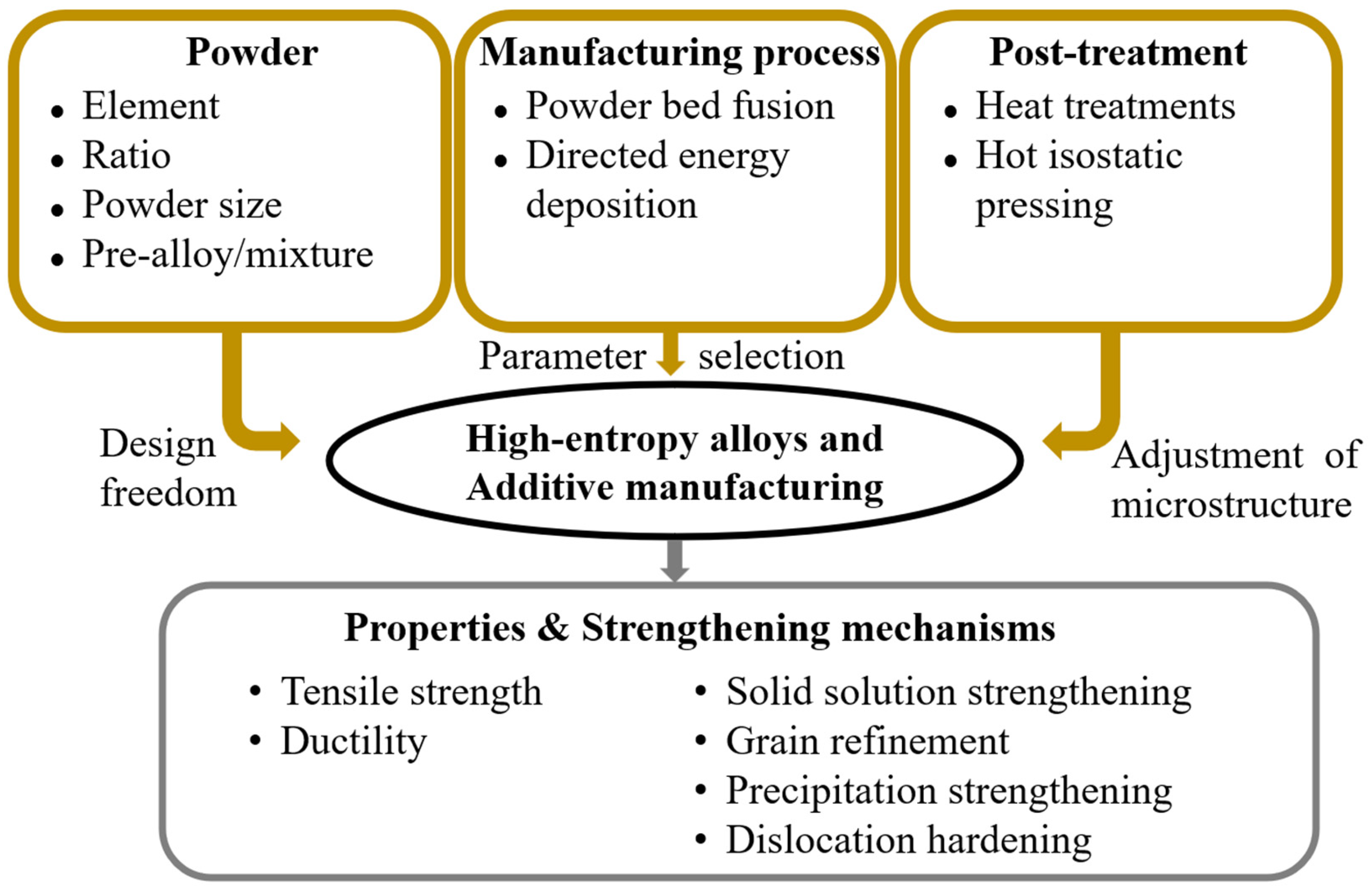



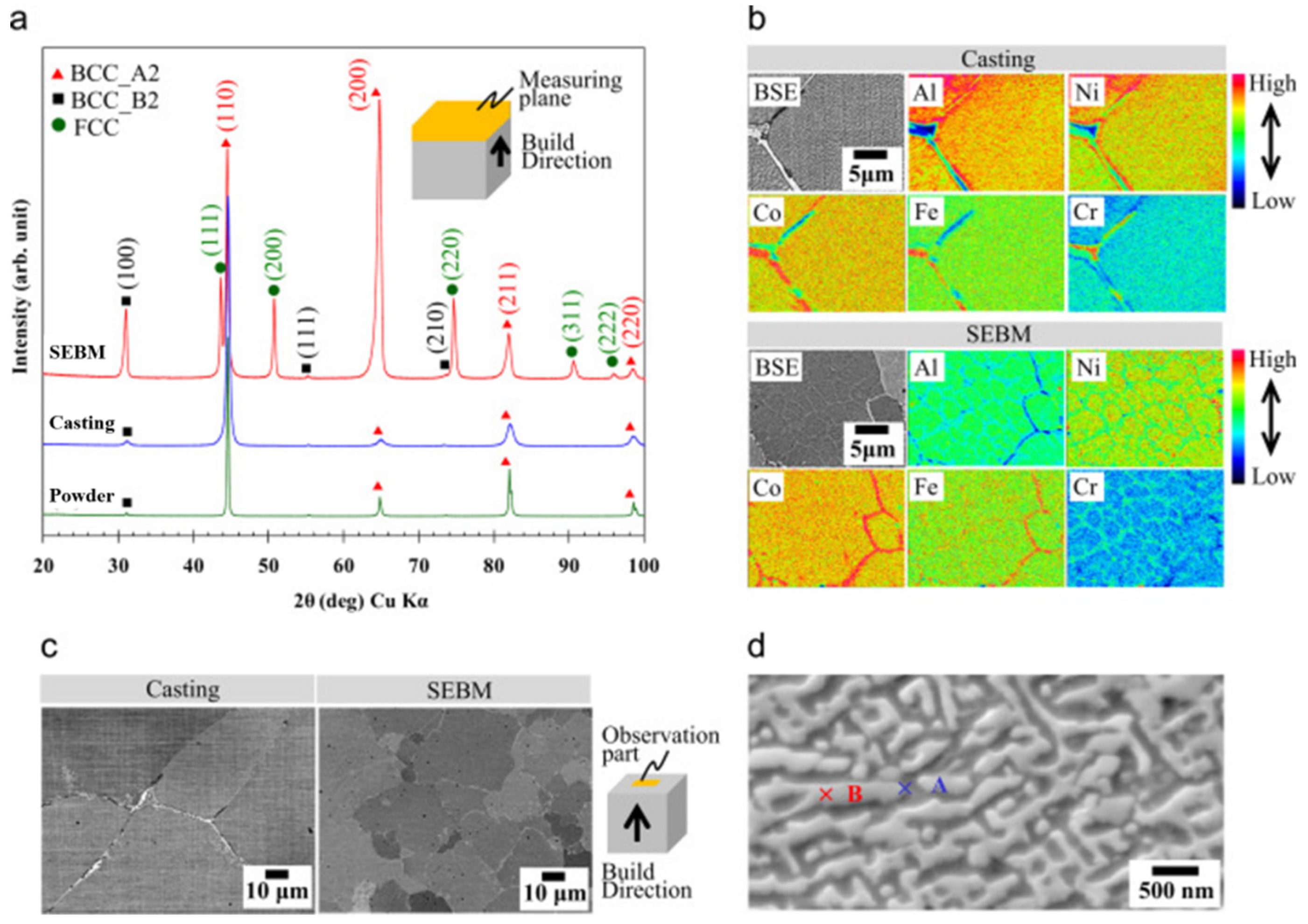
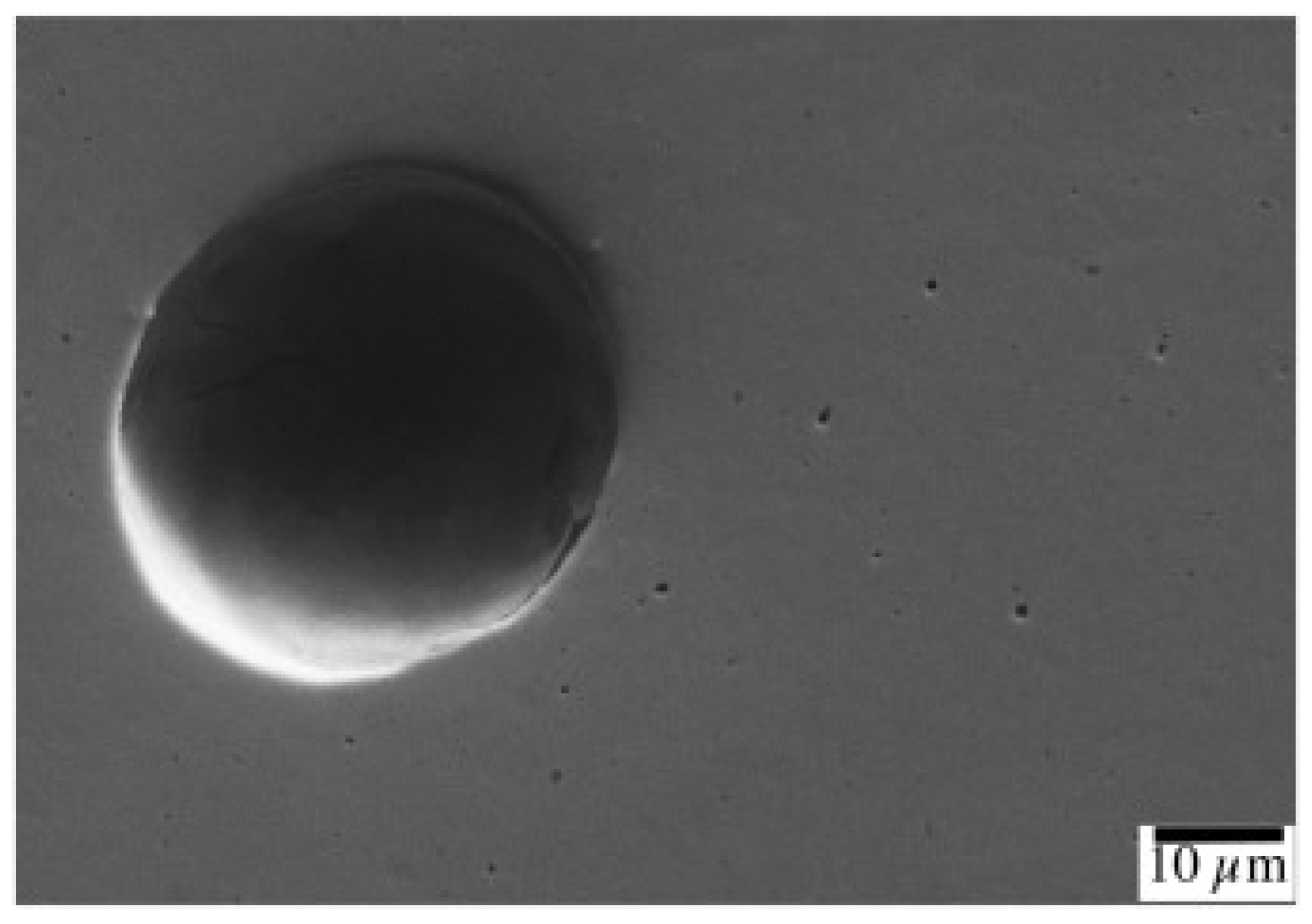
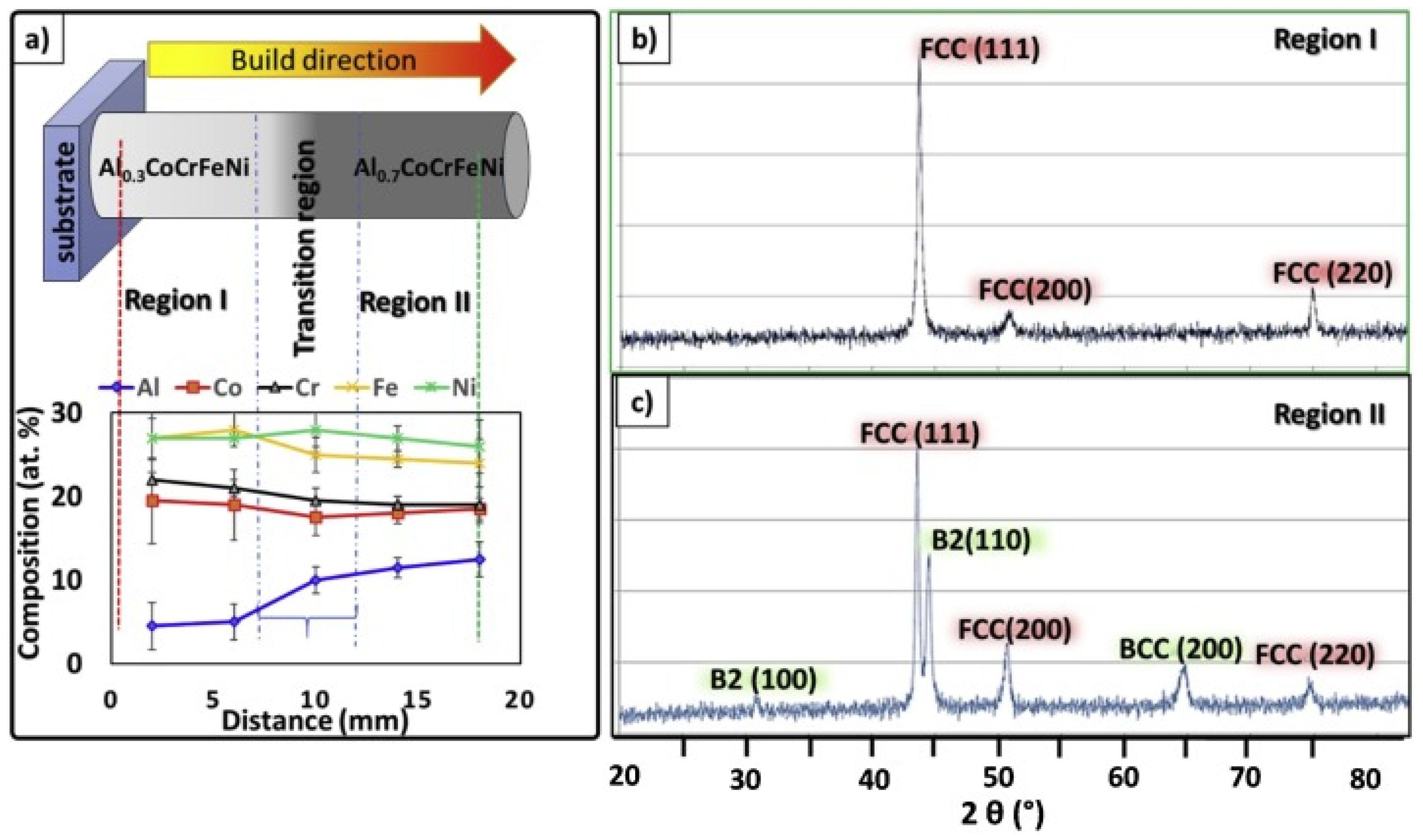
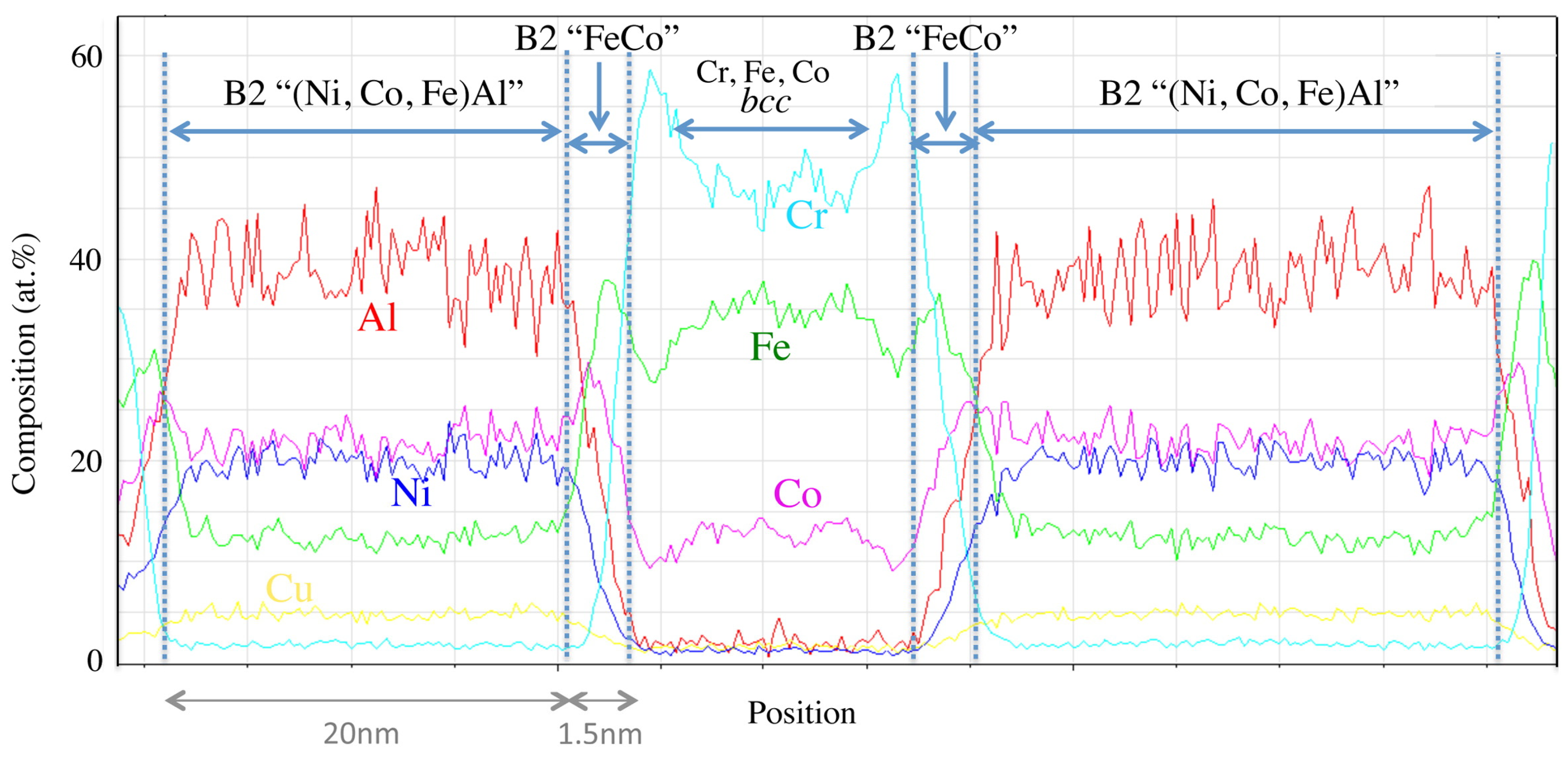

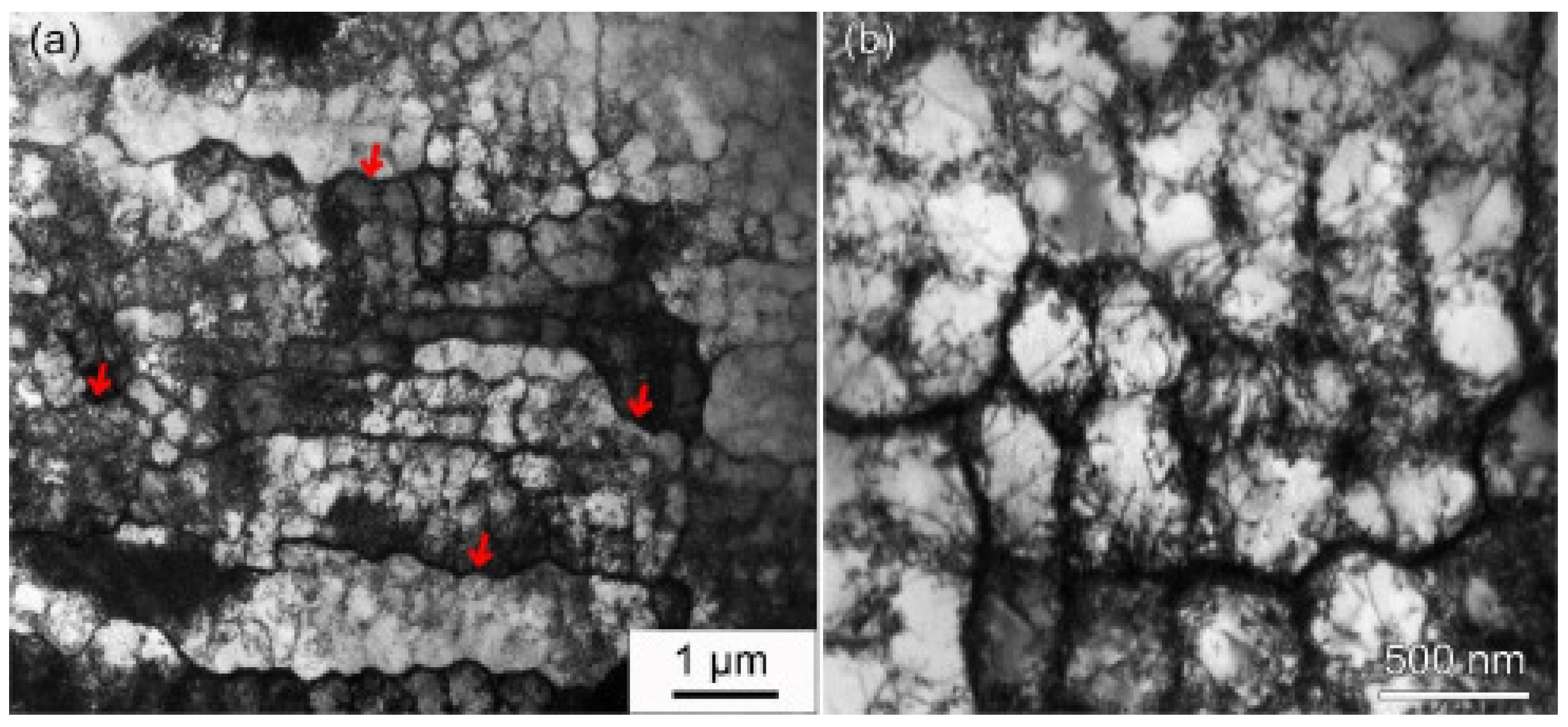
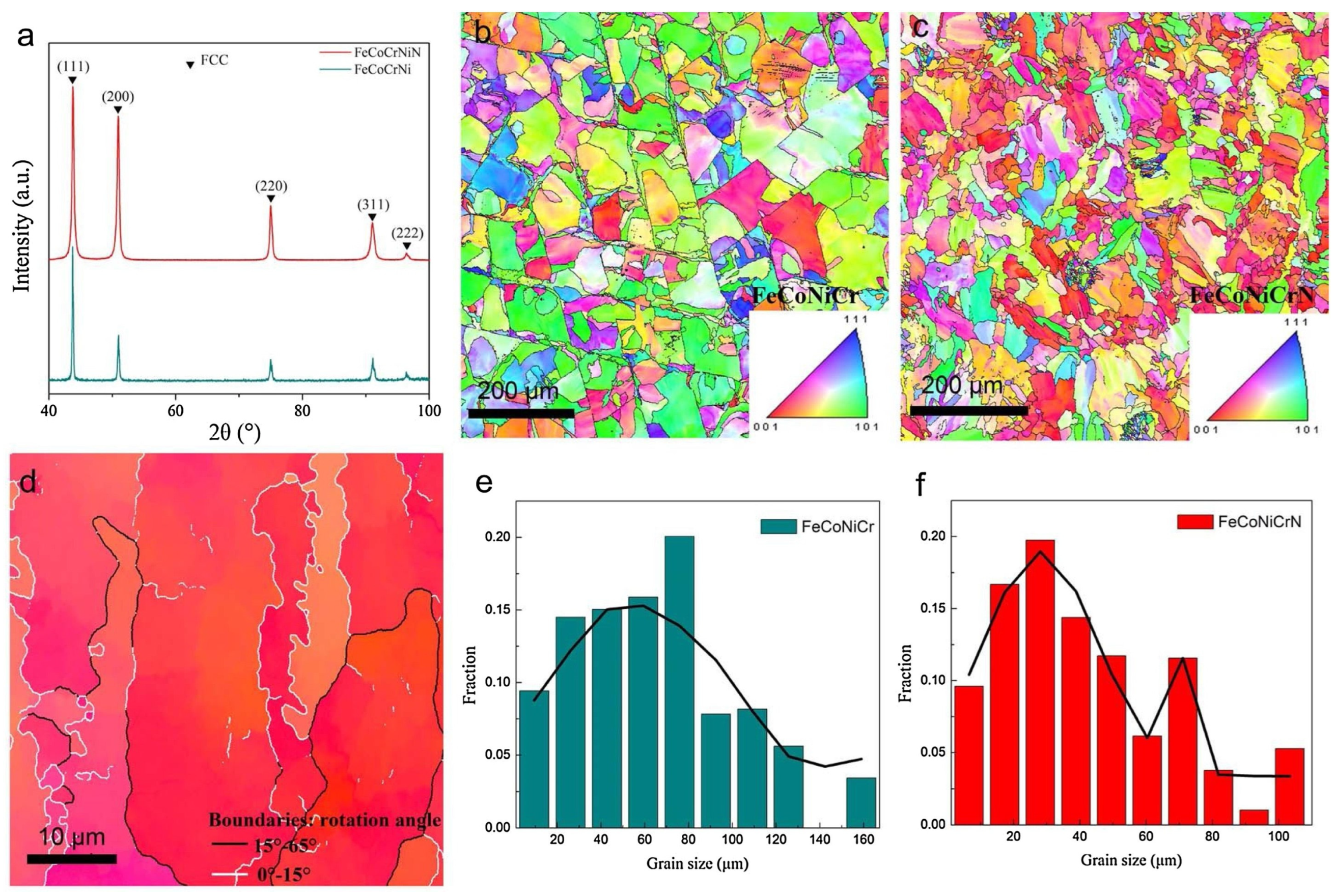

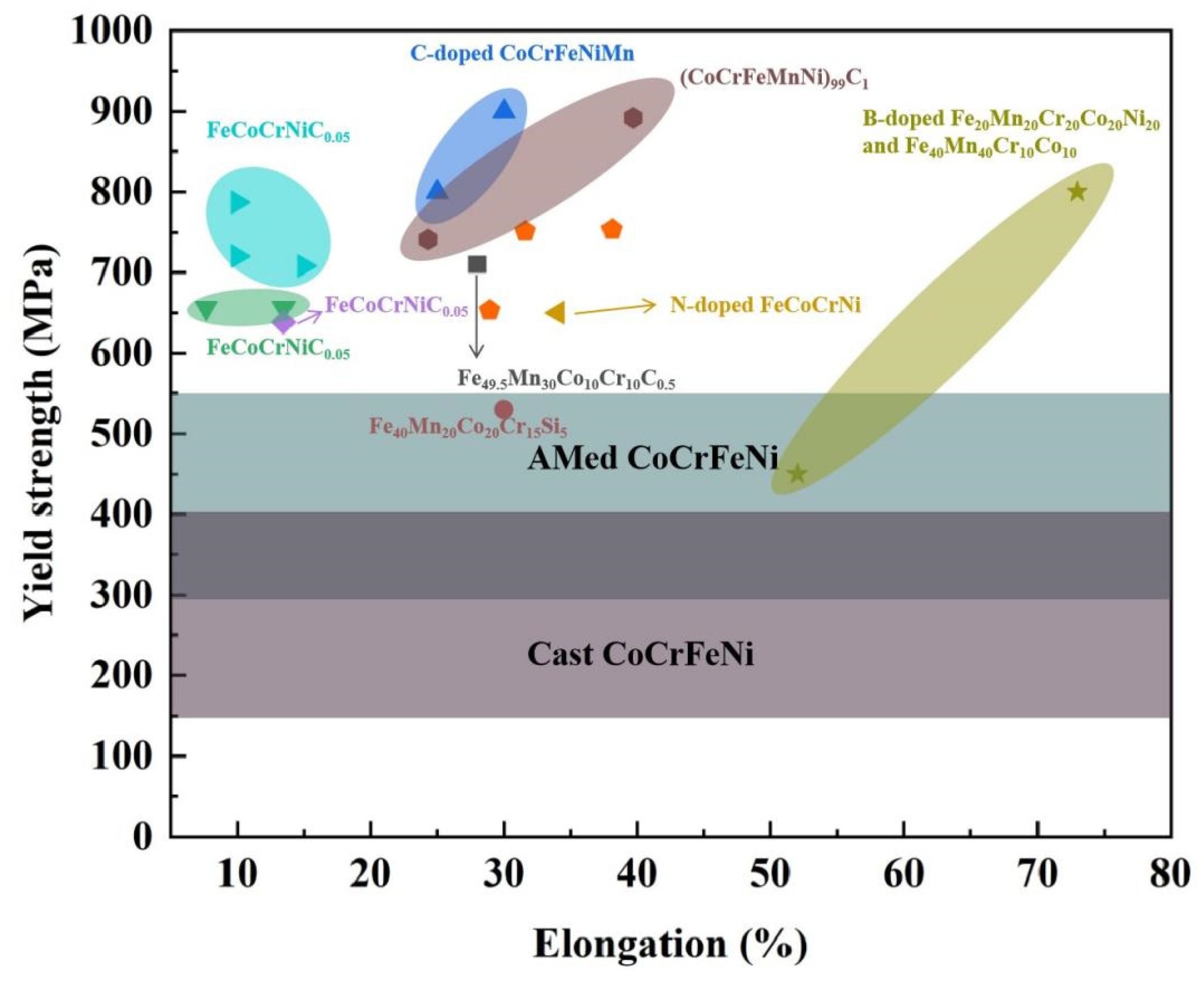
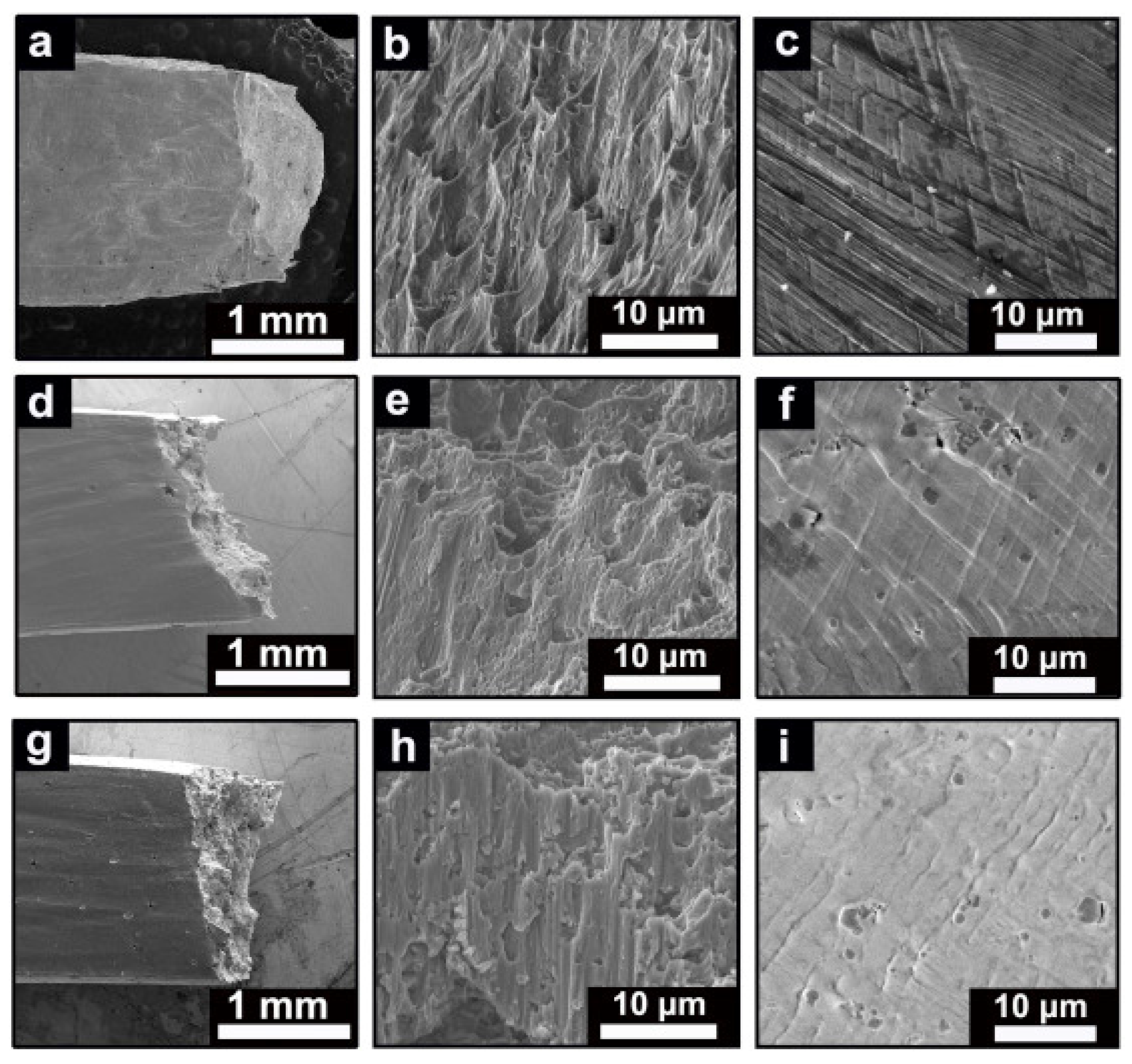
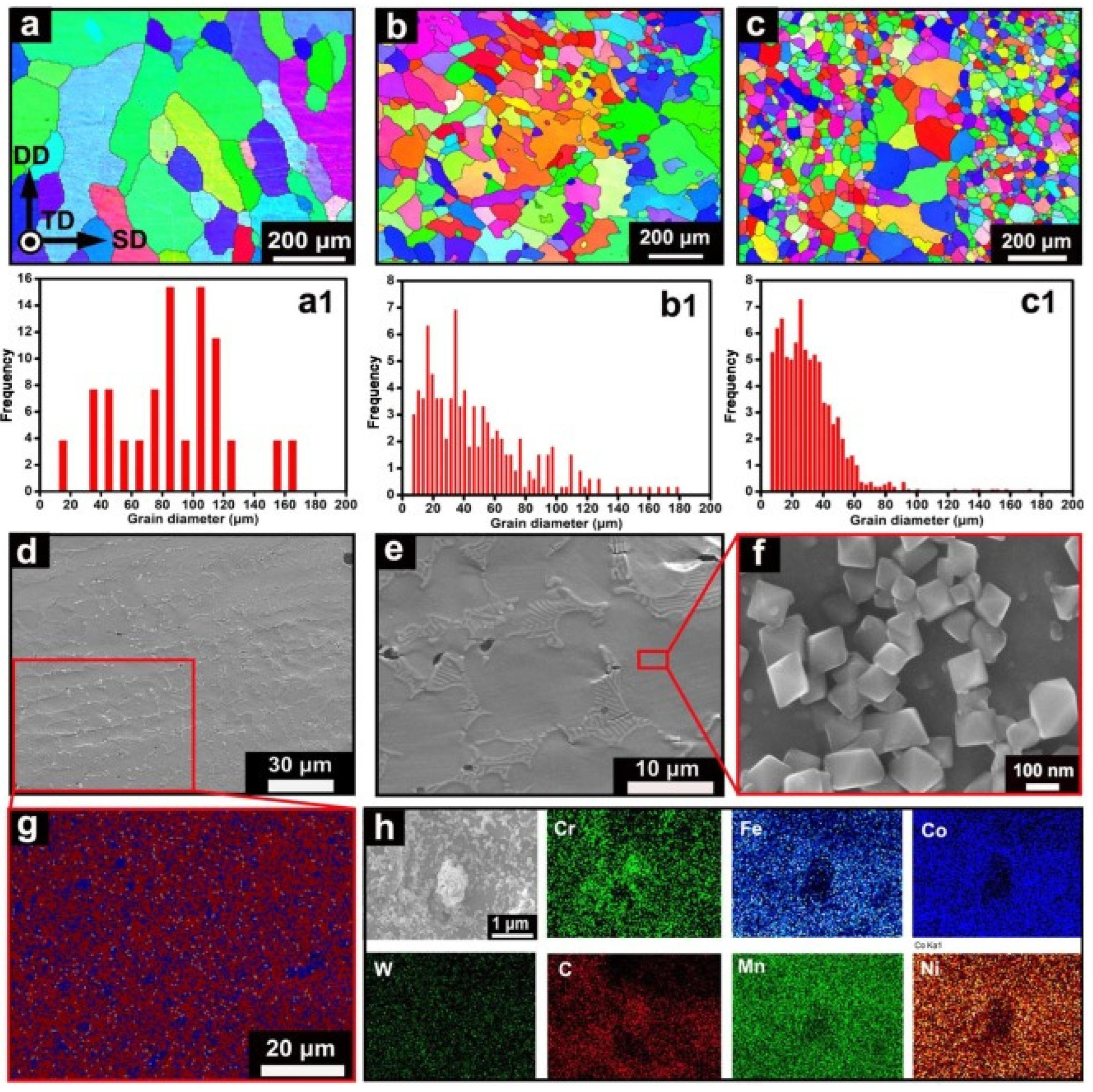
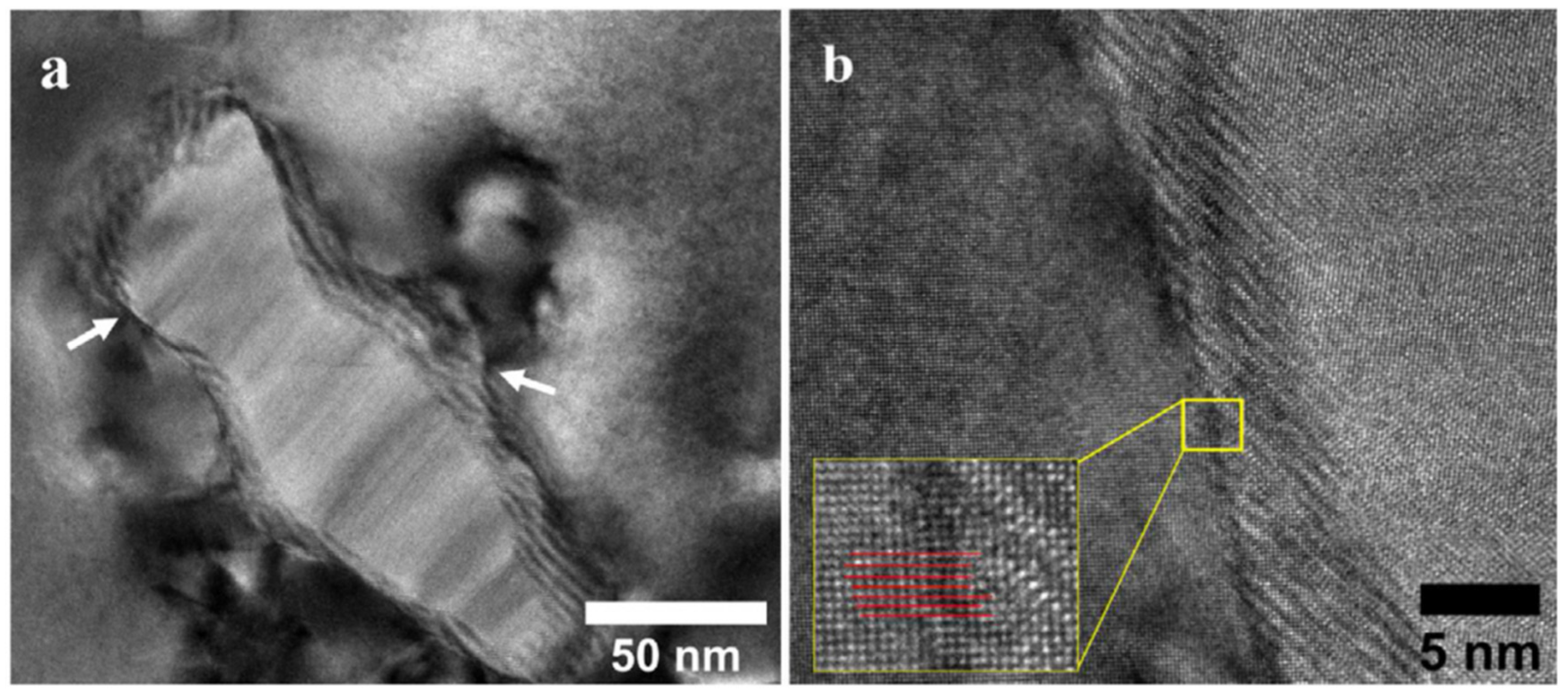
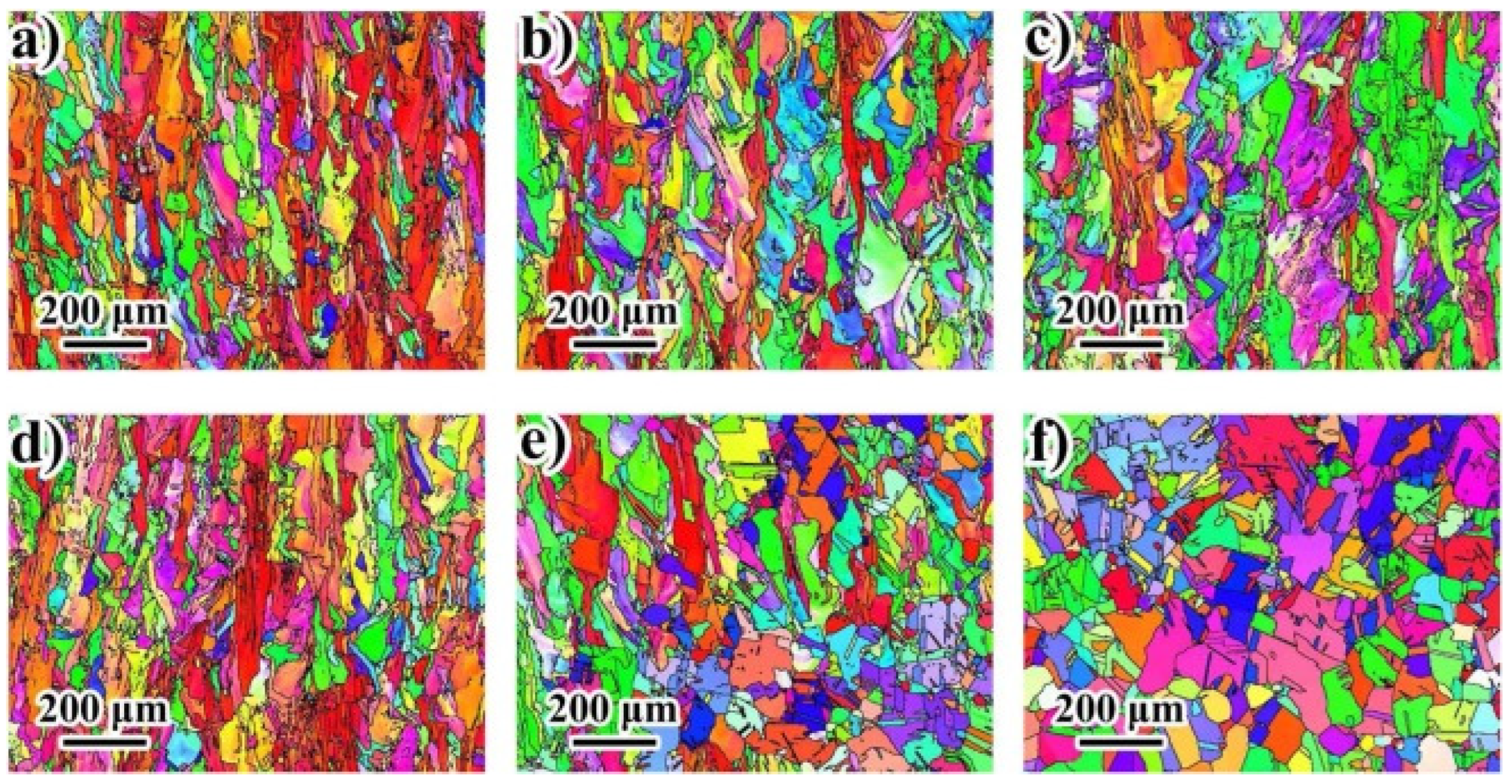

| HEA | Apparatus | Processing Parameter | Optimal Relative Density | Phase | Ref. | |
|---|---|---|---|---|---|---|
| Powder | As-Built | |||||
| Al0.1CoCrFeNi, Al0.5CoCrFeNi and Al1.0CoCrFeNi | SLM 250 HL | P = 150 W; v = 270 mm/s; h = 100 μm; L = 50 μm | - | - | FCC + BCC (present within alloy 0.5Al and 1.0Al) | [53] |
| Al0.3CoCrFeNi | PROX DMP 200 | P = 150–170 W; v = 1100–1300 mm/s; h = 60–80 μm; L = 50 μm | 99.9% | - | FCC | [54] |
| Al0.5CoCrFeNi | - | P = 160–320 W; v = 400–2000 mm/s; h = 45 μm; L = 25–30 μm | 99.92% | - | FCC + BCC | [55] |
| AlCoCrFeNi | Concept Laser Mlab | P = 98 W; v = 2000 mm/s; h = 52 μm | - | - | B2 + BCC | [56] |
| AlCoCrFeNi2.1 | EOS M290 | P = 350–370 W; v = 950–1000 mm/s; h = 80–100 μm; L = 40 μm | >99.5% | - | FCC + BCC | [40] |
| AlCoCrFeNi2.1 | NCL–M2150T | P = 240 W; v = 900 mm/s; h = 70 μm; L = 30 μm | - | FCC + BCC | FCC + BCC | [57] |
| Al0.5FeCoCrNi | Farsoon FS271 M | P = 400 W; v = 1600 mm/s; h = 90 μm; L = 40 μm | - | FCC + BCC | FCC | [58] |
| CoCrFeMnNi | Concept Laser M2 | P = 110–280 W; v = 800–2000 mm/s; h = 45–50 μm; L = 30 μm | - | FCC for CoCrFeNi α -Mn for Mn | FCC | [38] |
| CoCrFeNiMn | Prox 300 | P = 240 W; v = 2000 mm/s; L = 40 μm | 99.2% | - | - | [43] |
| CoCrFeMnNi | SLM125HL | P = 150–300 W; v = 600–1000 mm/s; h = 60/100 μm | - | - | - | [59] |
| CoCrFeMnNi | Farsoon FS271 M | P = 400 W; v = 800–4000 mm/s; h = 90 μm; L = 30 μm | 98.2% | FCC | FCC | [60] |
| CoCrFeMnNi | LPBF solutions 280 HL | P = 160 W; v = 800 mm/s; h = 50 μm; L = 30 μm | >99.2% | - | - | [61] |
| Co1.5CrFeNi1.5Ti0.5Mo0.1 | EOSINT M280 | P = 160–270 W; v = 540–1350 mm/s; h = 80–120 μm; L = 40 μm | >99.3% | - | FCC + SC | [62] |
| FeCoCrNiMn/Fe-based metallic glasses | HUSTBMG-I | P = 185 W; v = 600 mm/s; h = 100 μm; L = 40 μm | - | - | Two different FCC + amorphous phases | [63] |
| 1.8 at% N/FeCoNiCr | FS271M | P = 400 W; v = 1200 mm/s; L = 30 μm | - | - | FCC | [64] |
| 0.2 wt.% C/CoCrFeMnNi | Concept Laser M. Lab | P = 90 W; v = 200 mm/s; h = 80 μm; L = 25 μm | - | - | FCC + Cr23C6 + MnO + MnS | [65] |
| 1 wt.% TiC/CoCrFeMnNi | LPBF-100 | P = 160 W; v = 400–1000 mm/s; h = 50 μm; L = 30 μm | >99.4% | - | FCC | [66] |
| 2 wt.% TiC/CoCrFeMnNi | LPBF solutions 280 HL | P = 160 W; v = 800 mm/s; h = 50 μm; L = 30 μm | >99.6% | - | matrix + TiC | [61] |
| 5 wt.% TiN/CoCrFeNiMn | Beijing Yibo 3D Technology YBRP-150 | P = 200 W; v = 200–1200 mm/s; h = 80–100 μm; L = 40 μm | >99% | - | FCC + TiN | [67] |
| 12 wt.% TiN/CoCrFeNiMn | - | P = 250 W; v = 450 mm/s; h = 75 μm; L = 45 μm | - | - | FCC + TiN | [68] |
| (CoCrFeMnNi)99C1 | Concept Laser Mlab | P = 90 W; v = 200/600 mm/s; h = 80 μm; L = 25 μm | - | - | FCC | [59] |
| CoCrFeNiC0.05 | Farsoon FS271M | P = 400 W; v = 800 mm/s | - | - | FCC | [41] |
| CoCrFeNiMn | ProX 300 | P = 160–290 W; v = 1500–2500 mm/s; h = 50 μm; L = 40 μm | 99.2% | - | FCC | [44] |
| CoCrFeNiTiMo | - | P = 100–400 W; v = 200–800 mm/s; h = 120 μm; L = 50 μm | 99.8% | SC + FCC | SC + FCC | [69] |
| FeCoCrNiC0.05 | Farsoon FS271 M | P = 200–400 W; v = 800–2000 mm/s | 99% | FCC | FCC | [42] |
| FeCoCrNiC0.05 | Farsoon FS271 M | P = 400 W; v = 800 mm/s | - | - | FCC | [70] |
| HEA | Apparatus | Processing Parameter | Optimal Relative Density | Phase | Ref. | |
|---|---|---|---|---|---|---|
| Powder | As-Built | |||||
| AlCoCrFeNi | Arcam A2X | L = 70 μm; T = 1173–1233 K | - | BCC | BCC + FCC | [75] |
| AlCoCrFeNi | Arcam A2X | I = 4.5–9 mA; v = 215 mm/s; d = 260 μm; L = 70 μm; T = 1223 K | - | - | FCC + BCC + B2 | [76] |
| AlCoCrFeNi | Arcam A2X | L = 70 μm; T =1173–1223 K | - | - | FCC + BCC + B2 | [78] |
| AlCoCrFeNi | Arcam A2X | I = 4.5–9 mA; v = 215 mm/s; d = 260 μm; L = 70 μm; T = 1223 K | - | - | FCC + BCC + B2 | [81] |
| Co1.5CrFeNi1.5Ti0.5Mo0.1 | Arcam A2X | L = 70 μm; T= 1173–1253 K | - | - | SC/FCC + Ni3Ti (disappeared using solution treatment) | [77] |
| CoCrFeNiMn | - | I = 2–14 mA; v = 492–3446 mm/s; d = 50–150 μm; L = 50–70 μm; T = 1173–1253 K | 99% | FCC | FCC | [80] |
| HEA | Apparatus | Energy Source | Processing Parameters | Phases | Ref. | |
|---|---|---|---|---|---|---|
| AlCoCrFeNi | - | Laser | P = 600–650 W; v = 5 mm/s; L = 0.7–0.8 mm | BCC | [46] | |
| AlCoCrFeNi | TRUMPF TruLaser Cell 7040 | Laser | P = 800 W; v = 800 mm/min; L = 0.25 mm; | FCC + BCC | [89] | |
| AlCoCrFeNi | LENS MR7 | Laser | v = 2.5–40 mm/s;L = 0.15 mm; | B2 | [90] | |
| AlCoCrFeNi2.1 | optomec MR7 | Laser | P = 900 W; v = 900 mm/min; u = 30 g/min | BCC + L12 | [91] | |
| AlCoCrFeNi2.1 | DML-V03AD | Plasma arc | v = 5 mm/s; P = 80 A | FCC + B2 + sigma phase | [92] | |
| Al0.3CoCrFeNi | LENS-750 | Laser | P = 300 W; v = 170 mm/s; h = 0.381 mm; L= 0.254 mm | FCC + L12 | [93] | |
| Al0.3Ti0.2Co0.7CrFeNi1.7 | Optomec LENS-750 | Laser | P = 300 W; v = 12.7 mm/s; h = 0.381 mm; | FCC + L12 | [94] | |
| AlxCoCrFeNi (x = 0.3, 0.6 and 0.85) | TRUMPF TruLaser Cell 7040 | Laser | P = 800 W; v = 800 mm/min; L = 0.25 mm; h = 2.6 mm | FCC (x = 0.3); FCC + BCC (x = 0.6); BCC + σ phase (x = 0.85) | [95] | |
| CoCrFeMnNi | - | Laser | P = 370 W; v = 800 mm/min; u = 2 g/min | FCC | [84] | |
| CoCrFeMnNi | - | Laser | P = 300 W; v = 600 mm/min | FCC + BCC | [96] | |
| CoCrFeNiMn | - | Laser | P = 880 W; v = 10 mm/s; u = 8.6 g/min | - | [97] | |
| CoCrFeNiMn | - | Laser | P = 350–400 W; v = 400–600 mm/min; L = 0.25–0.3 mm | FCC | [83] | |
| CoCrFeNiMo | - | Laser | P = 950 W; v = 250 mm/min; L = 0.3 mm; u = 9.5 g/min | FCC + σ + μ phase | [79] | |
| CoCrFeNiMo0.2 | - | Laser | P = 1000–1400 W; v = 400 mm/min; L = 0.25 mm | FCC | [98] | |
| CoCrFeNiMo0.2 | - | Laser | P = 1000–1400 W; u = 7–9 g/min; L = 0.25 mm | FCC | [85] | |
| CoCrFeNiNbx (x = 0, 0.1, 0.15, 0.2) | - | Laser | P = 1600–1650 W; v = 7 mm/s | FCC (x = 0, 0.1 and 0.15); FCC + Laves (x = 0.2); | [99] | |
| CoCrFeNiWx (x = 0, 0.2, 0.5, 0.7, and 1.0) | DML-V03AD | Plasma arc | v = 5 mm/s; P = 80 A; L = 3 mm | FCC (x = 0); FCC + μ phase (x = 2); FCC + BCC + μ phase (x = 7, 10) | [100] | |
| CrMnFeCoNi | - | Laser | P = 1700 W; v = 2 mm/s; u = 10 g/min | FCC | [86] | |
| CrMnFeCoNi | - | Laser | P = 1000–1400 W; v = 400 mm/min; L = 0.45 mm (single direction and dual direction) | FCC | [101] | |
| CrMnFeCoNi | - | Laser | P = 1000 W; v = 800 mm/min | FCC | [87] | |
| CrMnFeCoNi/x wt.% TiC (x = 0, 2.5 and 5) | - | Laser | - | FCC (x = 0); FCC + TiC (x = 2.5 and 5) | [102] | |
| CrMnFeCoNi/x wt.% WC (x = 0, 5 and 10) | - | Laser | P = 1000 W; v = 500 mm/min | FCC (x = 0 and 5); FCC + M23C6 (x = 10) | [103] | |
| FeCrCoMnNi | - | Laser | P = 600–1000 W; v = 800 mm/min; L = 0.8 mm; u = 10 g/min | FCC | [104] | |
| HEA Compositions | Manufacturing Process | Yield Strength (Mpa) | Ultimate Tensile Strength (Mpa) | Elongation (%) | Strengthening Mechanisms | Ref. |
|---|---|---|---|---|---|---|
| AlCoCrFeNi | EBM | 769 ± 12.7 (BD 0°) | 1073.5 ± 21.3 (BD 0°); 312.6 ± 114.5 (BD 90°) | 1.2 ± 0.2 (BD 0°); 0 (BD 90°) | - | [78] |
| AlCoCrFeNi2.1 | LPBF | 1329 | 1621 | 11.7 | Grain boundary strengthening and phase boundary strengthening within the nanolamellar structure and the high density of dislocation introduced using LPBF | [57] |
| AlCoCrFeNi2.1 | DED | 421.1 (top)/ 389.1 (bottom) | 929.1 (top); 981.8 (bottom) | 15.6 (top) 21 (bottom) | Second phase strengthening | [92] |
| AlCoCrFeNi2.1 | LPBF | 1333 | 1640 | 13.6 | Interface strengthening and dislocation strengthening introduced using LPBF | [40] |
| Al0.3CoCrFeNi | LPBF | 730 | 896 | 29% | High dislocation density caused by using LPBF, grain refinement and crystallographic texture | [54] |
| Al0.3CoCrFeNi | DED+Annealing | 410; 500 (500 °C with 100 h); 630 (620 °C with 50 h) | - | 28 (500 °C with 100 h); 18 (620 °C with 50 h) | Precipitation strengthening | [93] |
| Al0.3CoCrFeNi | DED | 194 | 250 | 40 | - | [125] |
| Al0.3Ti0.2Co0.7CrFeNi1.7 | DED+Annealing | 700; 1000 (800 °C with 5 h); 1150 (600 °C with 50 h) | 1100; 1300 (800 °C with 5 h); 1420 (600 °C with 50 h) | 18; 5 (800 °C with 5 h); 4.5 (600 °C with 50 h) | Precipitation strengthening | [94] |
| Al0.5CoCrFeNi | LPBF | 609 | 878 | 18% | - | [60] |
| Al0.5FeCoCrNi | LPBF | 579 | 721 | 22% | - | [58] |
| AlxCoCrFeNi | DED | 200 (x = 0.3); 400 (x = 0.6); 1400 (x = 0.85); | 1300 (x = 0.3); 1500 (x = 0.6); 220 (x = 0.85); | 100 (x = 0.3); 78 (x = 0.6); 25 (x = 0.85); | Precipitation hardening and lattice distortion | [95] |
| AlxCoCrFeNi | LPBF | - | 300 (x = 0); 520 (x = 0.1); 900 (x = 0.5) | 12 (x = 0); 2 (x = 0.1); 10 (x = 0.5) | [53] | |
| Co1.5CrFeNi1.5Ti0.5Mo0.1 | LPBF+ST | 773.0 ± 4.2 | 1178 | 25.8 ± 0.6% | Grain refinement | [62] |
| EBM+ST | 743.4 ± 11.6 | 932.2 ± 4.8 | 4.0 ± 0.2% | Ni3Ti intermetallic compounds for strengthening | ||
| Co1.5CrFeNi1.5Ti0.5Mo0.1 | EBM+ST | - | 900; 1300 (ST-AC); 1100 (ST-WQ) | 4; 18 (ST-AC); 37 (ST-WQ) | Homogeneous precipitation with ultrafine size | [77] |
| CoCrFeMnNi | LPBF | - | 681 | 12.5 | The reaction between Mn and oxygen reaction lead to what? | [38] |
| CoCrFeNiMn | LPBF+HT | 465–510 | 541–609 | 19–34 | Dislocation strengthening, friction stress, and grain boundary strengthening | [44] |
| CoCrFeNiMn | EBM | 205 ± 3 | 497 ± 2 | 63 ± 1 | - | [80] |
| CoCrFeNiMo0.2 | DED | 532 (P = 1000 W); 557 (P = 1200 W); 560 (P = 1400 W) | - | 37 (P = 1000 W); 47 (P = 1200 W); 51 (P = 1400 W) | - | [98] |
| CoCrFeNiNbx (x = 0, 0.1, 0.15, 0.2) | DED | increase with the content of Nb | decrease with the content of Nb | The entanglement between the dislocations and the Laves phase | [99] | |
| CoCrFeNiTiMo | LPBF | 861 (BD 0°); 817 (BD 45°); 744 (BD 90°) | 861 (BD 0°); 817 (BD 45°); 744 (BD 90°) | 21 (BD 0°); 25 (BD 45°); 26 (BD 90°) | The anisotropic microstructure along BD and the existence of local strain | [69] |
| CoCrFeNiWx | DED | 186.8 (x = 0); 284.8 (x = 0.2); 461.9 (x = 0.5); 554.5 (x = 0.7); 566.7 (x = 1) | 526.6 (x = 0); 627.4 (x = 0.2); 786.8 (x = 0.5); 597.8 (x = 0.7); 566.7 (x = 1) | 50.8 (x = 0); 28.7 (x = 0.2); 2.6 (x = 0.5); 0.6 (x = 0.7); 0.3 (x = 1) | Solid solution strengthening caused by W and second phase strengthening | [100] |
| CrMnFeCoNi | DED | 353 | 564 | 26 | Refined grain and high density of dislocation introduced using DED | [86] |
| CrMnFeCoNi | DED | 517 | 660 | 26 | The lattice friction resistance, fine grain strengthening, and dislocation strengthening | [127] |
| CrMnFeCoNi | DED | 320.7; 427.4 (LSP = 1); 489.8 (LSP = 5) | 531.7; 570.7 (LSP = 1); 639.9 (LSP = 5) | 31.9; 40.1 (LSP = 1); 61 (LSP = 5) | LSP can improve the relative density of parts and accelerate grain refinement and the formation of nanotwins. | [87] |
| CoCrFeMnNi | LPBF+HIP | - | 601; 649 (HIP) | 35; 18 (HIP) | HIP can eliminate the micro-pore and micro-crack | [60] |
| CoCrFeNiMn | DED | 518 | 660 | 19 | Finer equiaxed grains and dendritic columnar grains and high density of dislocation introduced using DED | [97] |
| CoCrFeMnNi | DED+Annealing | 424; 232.2 (annealed) | 651.3; 647.1 (annealed) | 47.9; 58.3 (annealed) | High dislocation density and fine cell structure | [83] |
| HEA Composition | Manufacturing Process | Yield Strength (Mpa) | Ultimate Tensile Strength (Mpa) | Elongation (%) | Strengthening Mechanisms | Ref. |
|---|---|---|---|---|---|---|
| (CoCrFeNi)100−xNx (x = 0, 0.25 and 0.50 at. %) | LPBF | 530 (x = 0); 630 (x = 0.25); 730 (x = 0.5) | 707 (x = 0); 807 (x = 0.25); 850 (x = 0.5) | 43 (x = 0); 38 (x = 0.25); 29 (x = 0.5) | The interstitial strengthening caused by N | [146] |
| CoCrFeNi(SiC)x (x = 0, 0.1, 0.3 and 0.5) | DED | - | - | - | Second phase strengthening and solid solution strengthening. | [143] |
| CoCrFeNi-1 wt.% B4C | LPBF | 1249.5 | 1421 | 10.60% | Hall–Petch strengthening, precipitate strengthening | [144] |
| CrMnFeCoNi-x wt.% TiC (x = 0, 0.25 and 0.5) | DED | 300 (x = 0); 330 (x = 0.25); 385 (x = 0.5) | 550 (x = 0); 610 (x = 0.25); 723 (x = 0.5) | 50 (x = 0); 47 (x = 0.25); 32 (x = 0.5) | Dislocation movements are impeded by the addition of TiC | [102] |
| CoCrFeMnNi-5 wt.% NbC | LPBF+HT | 870 | 1050 | 15 | Grain refinement and dislocation strengthening | [145] |
| CoCrFeMnNi-12 wt.% TiN | LPBF | - | 1100 | 7.5 | The addition of TiN causes grain refinement. | [67] |
| CrMnFeCoNi-5 wt.% Fe54.5Cr18.4Mn2.0Mo13.9W5.8B3.2C0.9Si1.3 | LPBF | 675 | 820 | 12.3 | Dislocation strengthening caused by the difference of thermal expansion coefficients between Fe-based metallic glass and matrix, solid solution strengthening, grain refinement strengthening, dispersion strengthening | [149] |
| FeCoCrNiMn-x wt.% Fe43.7Co7.3Cr14.7Mo12.6C15.5B4.3Y1.9 (x = 5, 10, 20 and 30) | LPBF | 315 (x = 0); 384 (x = 5); 595 (x = 10); 916 (x = 20) | - | 80 (x = 5); 58 (x = 10); 39 (x = 20) | The solid solution strengthening caused by the atomic size mismatch between FeCoCrNiMn and the amorphous alloy and the resistance towards dislocation motion by the particle. | [63] |
| CrMnFeCoNi-x wt.% WC (x = 0, 5 and 10) | DED | 300 (x = 0); 502 (x = 5); 675 (x = 10) | 550 (x = 0); 776 (x = 5); 845 (x = 10) | 50 (x = 0); 37 (x = 5); 9 (x = 10) | M23C6 precipitates are formed, which hinder the propagation of slip bands, grain refinement, and precipitate strengthening. | [103] |
Disclaimer/Publisher’s Note: The statements, opinions and data contained in all publications are solely those of the individual author(s) and contributor(s) and not of MDPI and/or the editor(s). MDPI and/or the editor(s) disclaim responsibility for any injury to people or property resulting from any ideas, methods, instructions or products referred to in the content. |
© 2024 by the authors. Licensee MDPI, Basel, Switzerland. This article is an open access article distributed under the terms and conditions of the Creative Commons Attribution (CC BY) license (https://creativecommons.org/licenses/by/4.0/).
Share and Cite
Wu, Z.; Wang, S.; Jia, Y.; Zhang, W.; Chen, R.; Cao, B.; Yu, S.; Wei, J. Review on the Tensile Properties and Strengthening Mechanisms of Additive Manufactured CoCrFeNi-Based High-Entropy Alloys. Metals 2024, 14, 437. https://doi.org/10.3390/met14040437
Wu Z, Wang S, Jia Y, Zhang W, Chen R, Cao B, Yu S, Wei J. Review on the Tensile Properties and Strengthening Mechanisms of Additive Manufactured CoCrFeNi-Based High-Entropy Alloys. Metals. 2024; 14(4):437. https://doi.org/10.3390/met14040437
Chicago/Turabian StyleWu, Zhining, Shanshan Wang, Yunfeng Jia, Weijian Zhang, Ruiguang Chen, Boxuan Cao, Suzhu Yu, and Jun Wei. 2024. "Review on the Tensile Properties and Strengthening Mechanisms of Additive Manufactured CoCrFeNi-Based High-Entropy Alloys" Metals 14, no. 4: 437. https://doi.org/10.3390/met14040437
APA StyleWu, Z., Wang, S., Jia, Y., Zhang, W., Chen, R., Cao, B., Yu, S., & Wei, J. (2024). Review on the Tensile Properties and Strengthening Mechanisms of Additive Manufactured CoCrFeNi-Based High-Entropy Alloys. Metals, 14(4), 437. https://doi.org/10.3390/met14040437







